Analysis User Manual
Version 1.1.0 - Release date: May 10th, 2023
Developed by:
-
Brian J. Soher, Ph.D. - Duke University, Department of Radiology, Durham, NC
-
Philip Semanchuk - Duke University, Department of Radiology, Durham, NC
-
Karl Young, Ph.D. - University of California, San Francisco, CA
-
David Todd, Ph.D. - University of California, San Francisco, CA
Citation
If you publish material that makes use of Vespa, please cite:
Soher B, Semanchuk P, Todd D, Ji X, Deelchand D, Joers J, Oz G and Young K.
Vespa: Integrated applications for RF pulse design, spectral simulation and MRS data analysis. Magn Reson Med. 2023;1‐16. epub doi: 10.1002/mrm.29686
NIH and Other Grant Support
R01 EB008387, R01 EB000207, R01 NS080816 and R01 EB000822
1. Introduction to Analysis
1.1 Functionality
Vespa-Analysis is an application written in the Python programming language that allows users to interactively read, process and analyze MR spectroscopic data. Analysis allows users to:
-
Read one or more single voxel data files from various standard formats.
-
Perform typical spatial and/or spectral Fourier processing steps.
-
Apply HLSVD methods to remove unwanted signal components.
-
Apply iterative time domain + frequency domain metabolite and baseline models to fit MRS data and estimate metabolite signal areas.
-
Observe graphically the results of processing steps ‘on the fly'.
-
Store processed results and processing settings into a human readable XML format.
-
Do side-by-side comparison of results from two or more data sets.
-
Output results in text or graphical format
-
Exchange data and processing settings between users.
1.2 Basic Concepts
What is a Dataset? A ‘Dataset' consists of one or more raw single voxel data sets. Single voxel data can be ‘stacked into the screen' by selecting multiple files or from a single file with multiple 1D data sets stored in a 2D format. All Datasets can be traversed using a simple voxel widget selectors. The ‘Dataset' also contains information about all processing steps that have been performed on the data.
What is the Dataset Notebook? This is the main window of the Analysis application. It contains one or more Dataset Tabs, each of which contains the data and processing for an entire Dataset. Multiple Datasets can be loaded into the tabs of the Analysis application, but all the data loaded must have the same spatial and spectral dimensions. This is necessary to allow proper comparison between tabs.
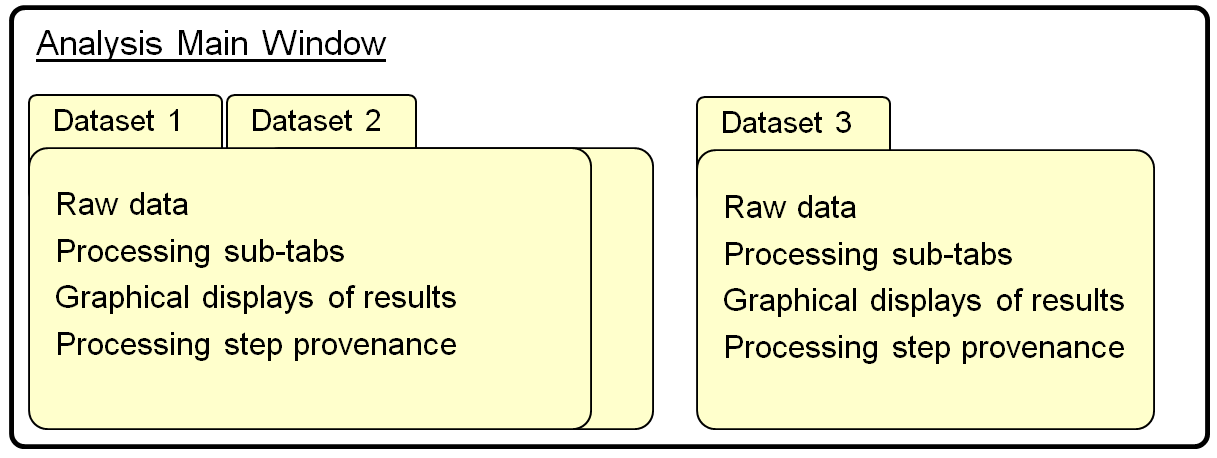
Datasets are processed through a progression of pipeline steps which are shown as Workflow Tabs within each Dataset Tab. These Workflow Tabs currently include ‘Raw Data', ‘Preprocess', ‘Spectral', ‘Fitting' and ‘Quant' steps, although only the ‘Raw' and ‘Spectral' Workflow Tabs are set up by default when data is loaded. The Workflow Tabs within a Dataset Tab contains a series of processing steps, known as its functor chain (shown in figure below). This maintains the current state of the Dataset for all processing parameters within its processing pipeline. Upon output, a full provenance for parameters and functor algorithms applied to the data is created as part of the Analysis XML output data format. A variety of graphical and text-based methods are available for saving results, as well.
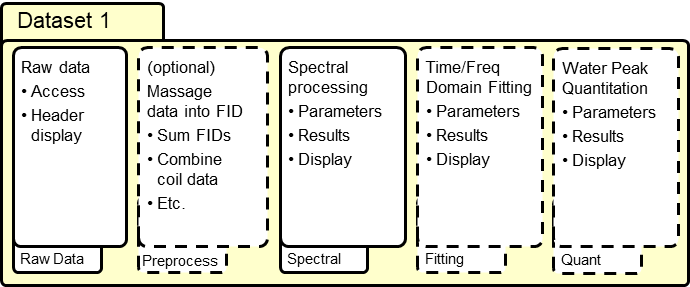
The following chapters run through the operation of the Vespa-Analysis program both in general and widget by widget.
In this manual, command line instructions will appear in a fixed-width font on individual lines, for example:
˜/Vespa-Analysis/ % ls
Specific file and directory names will appear in a fixed-width font within the main text.
References: Examples of spectral analysis using simulated spectral priors:
Young K, Govindaraju V, Soher BJ and Maudsley AA. Automated Spectral Analysis I: Formation of a Priori Information by Spectral Analysis. Magnetic Resonance in Medicine; 40:812-815 (1998)
Young K, Soher BJ and Maudsley AA. Automated Spectral Analysis II: Application of Wavelet Shrinkage for Characterization of Non-Parameterized Signals. Magnetic Resonance in Medicine; 40:816-821 (1998)
Soher BJ, Young K, Govindaraju V and Maudsley AA. Automated Spectral Analysis III: Application to in Vivo Proton MR Spectroscopy and Spectroscopic Imaging. Magnetic Resonance in Medicine; 40:822-831 (1998)
Soher BJ, Vermathen P, Schuff N, Wiedermann D, Meyerhoff DJ, Weiner MW, Maudsley AA. Short TE in vivo (1)H MR spectroscopic imaging at 1.5 T: acquisition and automated spectral analysis. Magn Reson Imaging;18(9):1159-65 (2000).
The following sections assume you have downloaded and installed Vespa-Analysis. See the Vespa Installation guide on the Vespa main project wiki for details on how to install the software and package dependencies. https://vespa-mrs.github.io/vespa.io/.
In the following, screenshots are based on running Analysis on the Windows OS, but aside from starting the program, the basic commands are the same on all platforms.
1.3 How to launch Vespa-Analysis
Double click on the Analysis icon that the installer created on your Desktop.
Shown below is the Vespa-Analysis main window as it appears on first opening. No actual Dataset windows are open, only the ‘Welcome' banner is displayed.
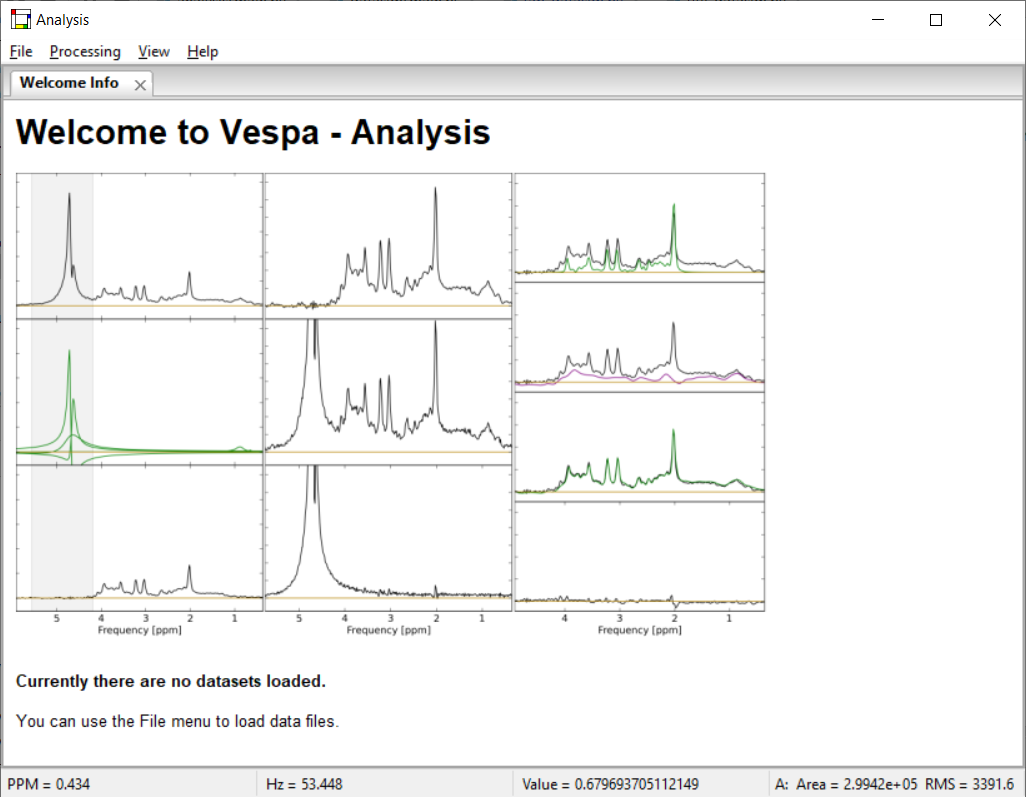
Use the File→Open menu to open existing Datasets into tabs, or the File→Import menu to load third party (MR scanner) data files into a Dataset.
Shown below is a screen shot of a Vespa-Analysis session with two Dataset Tabs opened side by side for comparison. Note that the data from Dataset2 has also been selected to be displayed in PlotB of Dataset1. The difference between the top and middle plots of Dataset1 is shown in the bottom plot. Also note that while Dataset1 tab has a Fitting tab, the Dataset2 tab does not. The functionality of all processing tabs will be described further in the following sections.
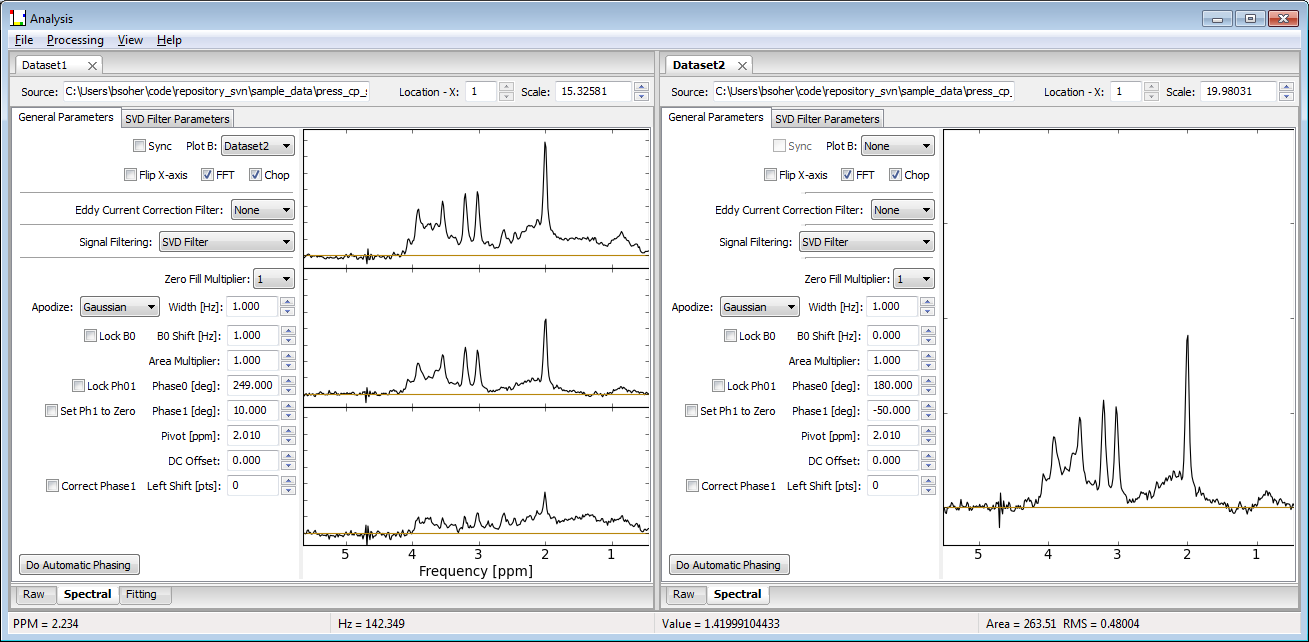
2. The Analysis Main Window
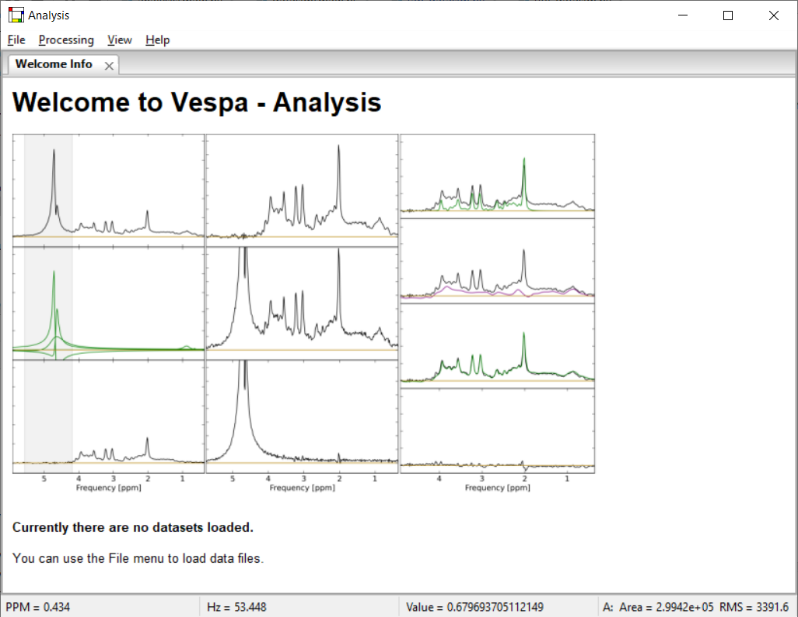
This is a view of the main Vespa-Analysis user interface window. It is the first window that appears when you run the program. It contains the dataset Notebook, a menu bar and status bar. The Dataset Notebook can be populated with one or more Dataset Tabs, each of which contains input data and results from one dataset. As described above, a Dataset is comprised of raw data plus a number of blocks of processing. Each processing block has its own Workflow Tab within its respective Dataset Tab. Workflow Tabs are organized along the bottom edge, while Dataset Tabs are organized along the top edge.
The Dataset Notebook initially displays a welcome text window, but no datasets are loaded. From the File menu bar you can 1) open a dataset that has previously been processed by Analysis and then saved into the Analysis VIFF XML format, or 2) import data from a variety of MRS formats into a new dataset. In either case, a tab will appear for each dataset opened/imported. The Processing menu adds optional Workflow Tabs to each Dataset Tab such as for time-domain/frequency-domain metabolite fitting. The View menu items set the plotting options for whichever Workflow Tab is active. The Help menu provides links to useful resources.
The status bar provides information about where the cursor is located within the various plots throughout the program. During plot zooms or region selections, it also provides useful information about the cursor start/end points and distances between. Finally, it also reports short messages that reflect current processing while events are running. An overview of the elements that can populate the notebook is shown below.
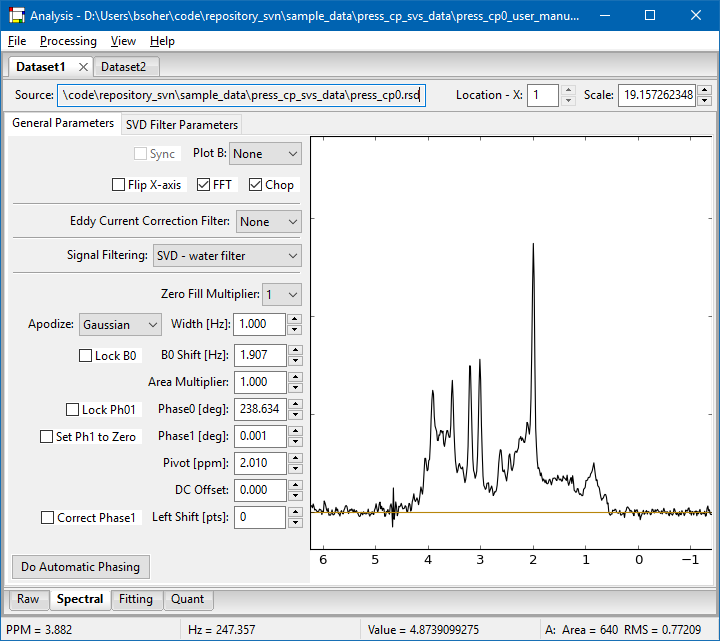
2.1 On the Menu Bar
These are the functions of various menu items in the application:
-
File → Open - Opens an existing VIFF dataset XML file into a new dataset tab in the dataset Notebook. The state of the dataset as it was saved, including all sub-tabs and results, are restored as the dataset is opened into its tab.
-
File → Import→<various> - This will allow the user to select one or more MRS data file, from a variety of data formats, that can be imported into the Analysis program and concatenated into a new dataset Tab. More information about importable data formats is given below.
-
File → Save - Saves the state of the dataset as it currently exists, including all sub-tabs and results, into a VIFF (Vespa Interchange File Format) XML file.
-
File → Close - Closes the active dataset tab.
-
File → Presets → LoadFromFile - Load parameter settings from a file and apply to the dataset in the active Tab.
-
File → Presets → SaveToFile - Save parameter settings from the dataset in the active Tab to a VIFF file.
-
File → Exit - Closes the application window.
-
Processing→Add Voigt Fitting Tab - Adds a Voigt model fitting workflow tab to the active dataset tab.
-
Processing→Edit User Spectral Information… Launches a modal dialog in which the user can create a simplified representation of the spectral lines in the data. User can add and delete lines of various line width, area and ppm location. This spectrum is used in automated B0 shift and Phase 0/1 estimation routines. Parameters for these routines can also be set in this dialog. See Section 2.5 for details.
-
Processing→Edit User Metabolite Information… Launches a modal dialog in which the user enter general information about the metabolites that might be used in the program, such as Full_Names, Abbreviations, Number of Spins, and Literature Concentration and T2 Decay values. User can add and delete metabolite info lines. Note – changes only take effect when user hits the OK button. No changes are applied if user hits Cancel.
-
View → <various> - (See Section 2.3) Changes plot options in the plots on each workflow tab of the active dataset tab, including: display a zero line, turn x-axis on/off or choose units, select the data type (real, imag, magn) displayed, and various output options for all plot windows.
-
Help → User Manual - Launches the user manual (from vespa/docs) into a PDF file reader.
-
Help → Analysis/Vespa Online Help - Online wiki for the Analysis application and Vespa project
-
Help → About - Giving credit where credit is due.
2.2 The Dataset Notebook
The dataset notebook is an "advanced user interface" widget (AUINotebook). What that means to you and me is a lot of flexibility: Multiple tabs can be opened inside the notebook. Tabs can be moved around, arranged and "docked" as the user desires by left-click and dragging the desired tab to a new location inside the notebook boundaries. In this manner, the tabs can be positioned side-by-side, top-to-bottom or stacked (as shown in Section 1). There is only the one Notebook in the Analysis application, but it can display multiple MRS data sets by loading them into Dataset Tabs.
Dataset Notebook Hierarchy:
-
The Dataset Notebook can contain 1 or more Dataset Tabs.
-
Each Dataset Tab will have 2 or more Workflow Tabs.
- Each Workflow Tab will display processing parameter widgets in either a single panel or two or more sub-tabs.
-
2.3 Dataset Tabs
The Dataset Notebook contains one or more Dataset Tabs, each of which contains the data, setting, and results of one Dataset. Dataset Tabs are arranged along the top of the notebook and can be grabbed (left-click and drag) and moved to different locations inside the notebook as you like. Dataset Tabs can be closed using the X box on the tab or with a middle-click on the tab itself. When a tab is closed, the Dataset is removed from memory. If the Dataset was saved to Vespa-Analysis VIFF file format before it was closed, it can be reopened at a later date. The VIFF format saved the Dataset in such a way that it can be restored to the current state at which it was saved the next time it is opened.
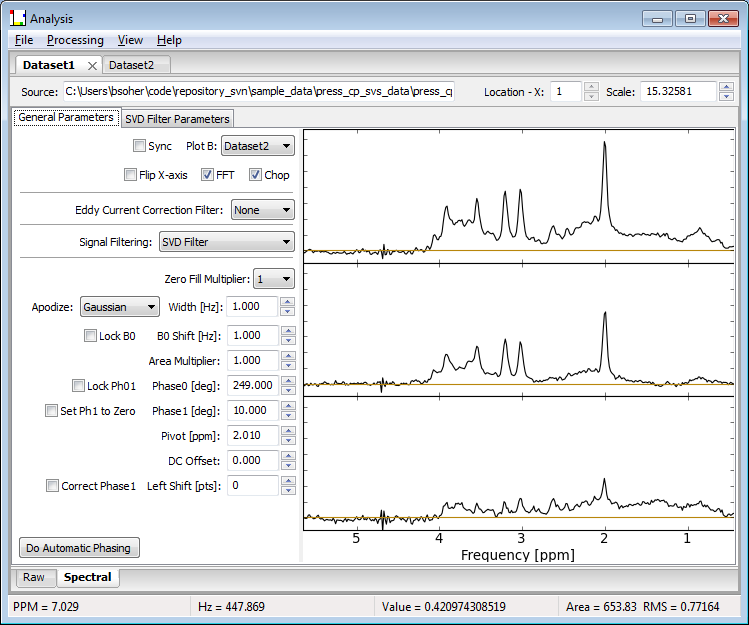
Each Dataset Tab has two or more Workflow Tabs that represent blocks of processing. Dataset Tabs are set up by default with the ‘Raw' and ‘Spectral' Workflow Tabs, which reflect, respectively, the import and organization of one or more MRS file(s) into the Analysis program and a variety of time and frequency domain spectral processing steps can be applied. Other optional Workflow Tabs include 1) fitting a spectral model to metabolites to the data and 2) quantitation of the fitted metabolites with respect to a water spectrum peak. Workflow Tabs are described in more detail in the following sections. The figure above shows Analysis with two Datasets open in the notebook. The active Dataset Tab has two Workflow Tabs, Raw and Spectral, and the Spectral tab is active.
A new Dataset Tab is only created when you import an MRS data file. It then processes the data through each Workflow Tab to create the desired results. Datasets are only saved to file when specifically requested by the user. On selecting File → Save, the current state of the dataset, ie. all data, settings and results in all tabs, is saved into a file in the Vespa Interchange File Format, or VIFF. This file can be updated at any time by hitting Save, or a new filename can be used by hitting Save As to save different states in different files. When a VIFF file is opened in Analysis, all Workflow Tabs and results are restored to the state in which they were saved.
Each Workflow Tab displays the filename of the loaded data, the x-voxel index, and the y-scale of the plot. As discussed in more detail in the following section, one or more MRS files can be loaded into a single Dataset Tab. When multiple files are loaded, the Dataset organizes them by stacking the data "into the screen". You can step through each spectrum in the dataset by increasing or decreasing the index in the ‘x-voxel' widget. Parameter values specific to each spectrum are automatically updated in the widgets of the Workflow Tab displayed.
The View menu on the main menu bar modifies the display of the plots in the active Workflow Tab. The state of plot options is maintained within each Workflow Tab as the user switches between them. The following lists the functions on the View menu item:
The following Menu Bar items affect the Plot Canvas in the currently active tab
-
View →ZeroLine→Show - toggle zero line off/on
-
View →ZeroLine→Top/Middle/Bottom - display the zero line in the top 10% region, middle or bottom 10% region of the canvas as it is drawn on the screen
-
View→ZeroLine Spectral/Series - (Preprocess tab) as above for top/middle/bottom, but for either the Spectral or Series plot windows.
-
View →Xaxis →Show - display the x-axis or not
-
View →Xaxis→PPM/Hz - x-axis value in PPM or Hz
-
View →Data Type - select Real, Imaginary, or Magnitude spectral data to display
-
View →Area Calc→Plot A/B/C - when the right mouse button is used to define a region along the x-axis, the status bar displays the area in the plot between the start/end of this region. This option selects whether the area is calculated from plot A, B or C.
-
View →Plot C Function - (Spectral tab only) the plot in the bottom canvas (aka plot C) of the spectral workflow tab can be either None, A-B or B-A. If ‘None' is selected, plot C is not displayed on the canvas
-
View →User Button Function - (Spectral tab only) User can select different functionality button at lower left in General Param tab
-
View →User Button Function →Auto Phasing - Applies an algorithm to automatically phase data in plot
-
View →User Button Function →Output Area Value - Writes areas under curve and between span selectors to a CSV text file selected by the user. If file already exists, the values are appended.
-
View→Derived Datasets→PlotA→<various> - (Spectral tab only) writes the values of the complex64 array displayed in PlotA (top plot) into either an ASCII or binary file using the numpy.tofile() method or into a Vespa VIFF file format. User is prompted for a filename. The entire vector in the plot is saved, not just the zoomed in portion (if zoom is applied). Note binary and ASCII functionality is provided as a convenience to users only and cannot be read back into Analysis.
-
View→Derived Datasets→PlotC→<various> - (Spectral tab only) writes the values of the complex64 array displayed in PlotC (bottom plot) into either an ASCII or binary file using the numpy.tofile() method or into a Vespa VIFF file format. User is prompted for a filename. The entire vector in the plot is saved, not just the zoomed in portion (if zoom is applied). Note binary and ASCII functionality is provided as a convenience to users only and cannot be read back into Analysis.
-
View→Derived Datasets→PlotC→Spectrum A+B->NewTab (Spectral tab only) regardless of what is in Plot C, this will perform a sum of plots A and B and insert this spectrum into a new Dataset tab. User is prompted for a filename. The entire vector in the plot is saved, not just the zoomed in portion (if zoom is applied). This is useful for performing DIFF/SUM processing of edited SVS data if ON/OFF spectra are available in plots A and B.
-
View→Derived Datasets→PlotC→Spectrum A-B->NewTab - (Spectral tab only) as above, regardless of what is in Plot C, this will perform a difference of plots A and B and insert this spectrum into a new Dataset tab.
-
View→Derived Datasets→SVD Exports - (Spectral tab only) saves spectral/FID data from the Spectral – SVD Filter Parameters subtab into VIFF XML raw data format files. User is prompted for a filename. The entire vector in the plot is saved, not just the zoomed in portion (if zoom is applied). In all cases, the data saved is time domain data (for Analysis compatibility). An inverse FFT is applied to the spectrum, if needed before data is saved.
-
View→Derived Datasets→SVD Exports→Plot A/B/C Spectrum - As above, but user can select which data to save from the three plots displayed. In Plot B, if individual lines are displayed, they are summed prior to being saved.
-
View →Output→View→<various> - writes the entire plot to file as either PNG, SVG, EPS or PDF format
-
View →Output→PlotA→<various> - (Spectral tab only) writes the values of the complex64 array displayed in PlotA (top plot) into either an ASCII or binary file using the numpy.tofile() method. User is prompted for a filename. The entire vector in the plot is saved, not just the zoomed in portion (if zoom is applied). Note this functionality is provided as a convenience to users only. This output format is not cross-platform compatible and can not be read back into Analysis
-
View →Results to File →Text-CSV Layout→Current or All voxels - (Fitting tab only) Creates a text file to store the result values for either the current voxel, or all voxels. Each voxel result is stored in a single line with each value separated by commas. User must select a filename. 1) The last used filename is stored for use as the default the next time the button is hit. 2) If the file does not exist, it is created and a separate header line containing all result column names is added before the result values. 3) If the file exists, the number of comma separated entries in the last line is calculated. If this number differs from the number of result values to be added, then a separate header line containing all result column names is added before the result values.
-
View →Results to File →LCM Layout→<various> - (Fitting tab only – all of these)
-
View →Results to File →Analysis 2-plot Layout→<various>
-
View →Results to File →Analysis 4-plot Layout→<various> - outputs fitting results in one of three standard layouts to a file in either PNG or PDF format. These layouts include both tabular information about fitted parameters and plotted spectral results.
2.4 Mouse Events in Plots
Most processing workflow tabs have plots in their right-hand panels. These plots may contain one or more axes which may change dynamically. For example, the SVD pane always has three axes displayed, but the Spectral tab may have one, two or three axes drawn. We will typically refer to these as top, middle and bottom plots, OR as Plot A, Plot B and Plot C respectively.
You can control a number of functions by using your mouse interactively within the plot area of most workflow tabs. Vespa-Analysis is best used with a ‘two-button' mouse that has a roller ball, but can also work fine with a true ‘two-button' mouse, as most mouse-driven features for the roller ball also have a corresponding widget that can be clicked on or typed in to cause the same effect. The following describes the typical actions that can be done using the mouse in a plot window. Any variations from this will be noted in the following workflow tab sections.
The mouse can be used to set the X-axis and Plot Cursor values in workflow tab plots. Where there are two or more plots, the same X-axis or Cursors are set on all three. The left mouse button sets both the X-axis zoom range and the Plot Cursors through the use of left mouse Click and left mouse Shift-Click, respectively.
To change the x-axis range: Click and hold the left mouse button in the window and a vertical cursor will appear. Drag the mouse either left or right and a second vertical cursor will appear. PPM values for the x-range indicators will be reflected in the status bar. Release the mouse and the plot will be redisplayed for the axis span selected. This zoom span will display its range in a pale yellow that disappears when the left mouse is released. Click in place with the left button and the plot will zoom out to its max x- and y-axis settings.
To change the plot cursors: Hold down the Shift Key and then Click and hold the left mouse button in the window and a vertical cursor will appear. Drag the mouse either left or right and a second vertical cursor will appear. PPM values for the plot cursor indicators will be reflected in the status bar. Release left mouse button to set the two cursors in the window. This cursor span will display as a light gray span. Left mouse button Shift-Click in place will reset (turn off) the cursor span.
The cursor values are used to determine the "area under the peak" values that are displayed in the status bar. While performing a right-click and drag to create a cursor span the status bar will also display the start/end location of the span and the delta Hz and delta PPM size of the span.
The roller bar can be used to increment/decrement the Y-axis scale value. A maximum value for the Y-axis scale is determined the first time a dataset is loaded and displayed. That max value is the value displayed in the scale widget (top right in the dataset) and used when you zoom all the way out. As you roll the ball up/down (or you click on the SpinCtrl widget next to the scale field) the scale value changes and the plot is updated. (Note. It may be necessary to actually click in the plot window to move the focus of the roller ball into the plot, before the roller ball events will be applied to the Scale value.)
The right mouse button can typically be used to apply zero and first order phase to the plots in the Plot Canvas. Click and drag the right button while inside a plot to change the values of the zero and first order phase (Phase0/1) of the data plotted in the window. By dragging the mouse up/down you change the zero order phase and by dragging left/right you change first order phase (unless that value has been ‘locked' to 0.0). The code that controls the Phase 0/1 changes measures if each mouse move is more up/down or more left/right and only adjusts one of the phase values at a time, respectively.
Note that the Phase0/1 value that is set in any workflow tab is also updated in all other workflow tabs (and stored internally in just one location). Thus, there is effectively only one Phase0/1 regardless of however many plots and workflow tabs there are in a dataset.
2.5 User Defined Prior Spectrum Dialog
This dialog is a bit of a catch-all for spectral information that is user-derived (or at least user editable) but that needs to be available for use in Workflow Tabs. As of this release, this dialog contains the User Defined Prior Spectrum (a.k.a. User Prior) control panel. This is shown in the figure right and described in more detail in the following paragraph.
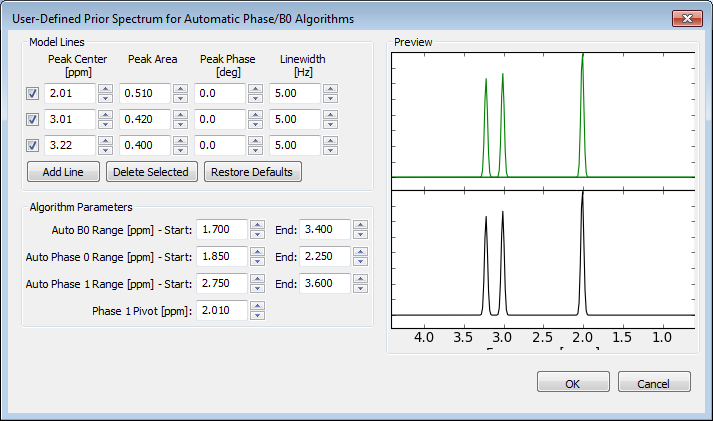
The User Prior control panel allows you to manually create prior information about the structure of the data to be analyzed that will enable automated B0 shift and Phase 0/1 routines to better estimate these values. The methods used in the automate phase and B0 shift routines need a model spectrum to compare to the corrected phased data. It is often not desirable to have a full blown model such as would be provided by the metabolite prior information (i.e. We may not want multiplet resonance structures). Often a simpler model is more effective, such as one that only contains singlets or other prominent metabolite features.
The plot to the right displays the spectrum you are designing. The top plot shows each individual line you add. The bottom plot shows the sum of all lines. You can zoom in/out of this plot the same as described in Section 2.4. You will likely need to zoom in to clearly see the lines you are creating.
2.5.1 On the User-Defined Prior Spectrum Dialog
-
Model Lines - Use the Add and Delete buttons to create however many lines you want in your AutoPrior spectrum. As you change values in the PPM, Area, Phase and Linewidth controls, this will be reflected in the plotted spectra.
-
Restore Defaults - (button) Resets the Model lines to a set of default 1H values (ie. NAA, Cr, Cho singlets).
-
Algorithm Parameters
-
Auto B0 Range - (spin controls) This is the range over which the B0 shift is optimized.
-
Auto Phase 0 Range - (spin controls) This is the range over which the zero order phase is optimized
-
Auto Phase 1 Range - (spin controls) This is the range over which the first order phase is optimized.
-
Phase 1 Pivot - (spin control) float, ppm. This is the pivot point used in the phase 1 calculation.
-
2.6 User Defined Metabolite Information Dialog
This dialog contains metabolite information that is typically user-derived (or at least user editable) but that needs to be available for use in Workflow Tabs. The widget is shown in the figure right and described in more detail in the following paragraph.
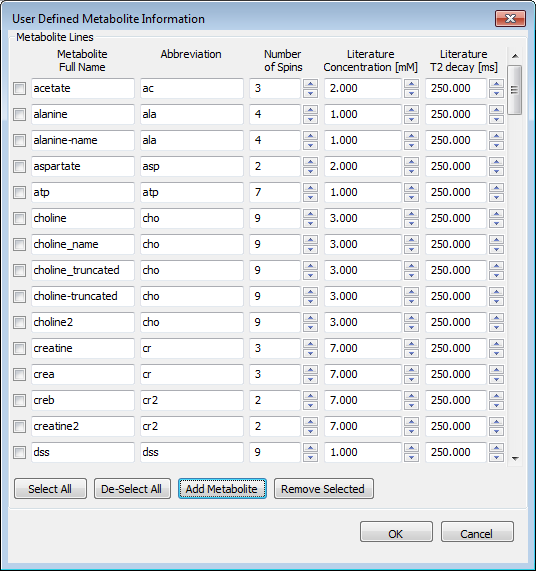
User Defined Metabolite Information dialog allows you to provide information about the metabolites to be analyzed in the application. The Metabolite Full Name (unique value) and Abbreviation (non-unique value) allow you to map metabolites created and used in Vespa-Simulation Experiment that have non-standard Full_Name. For example, you might have created a slightly changed version of myo-inositol called "mIns_bob". In this dialog, you would hit Add Metabolite and fill in "mIns_bob" as Full Name and then put "m-ins" into the Abbreviation field. Vespa-Analysis would then know to use the myo-inositol initial values algorithms when fitting your data.
The Number of Spins field accepts only integer values 1 or greater. These are used to map peak search peak heights to starting areas based on simulation peak areas normalized to the number of spins in a peak. For example, if a creatine simulation had a single peak with 3 protons and also a choline simulation that contained 9 spins, then the areas would differ by a factor of three to have initial peaks that were approximately the same height.
The Literature Concentrations are in millimolar values. These get used in Fitting initial values routines where there are no distinct peaks that can be searched for by a metabolite (e.g. taurine). In this case the program has the option to create starting values that are in proportion to literature NAA values.
The Literature T2 Decay values are planned for use in constraining the exponential decay parameter in the Voigt line model, but this is currently under construction. When finished, the T2 Decay value listed here will serve as a default value for a given metabolite when it is read in as a part of a basis set.
2.6.1 On the User-Defined Metabolite Information Dialog
-
Metabolite Lines - Use the Add and Delete buttons to create however many lines you want. Each line contains an entry for a unique Metabolite Full_Name, a non-unique Abbreviation, integer Number of Spins, and floating point Literature values for Concentration in mM and T2 Decay in ms. Changes will not take effect until use selects the OK button.
-
Select All - (button) Marks all check boxes at left side of Metabolite Lines as On.
-
De-Select All - (button) Marks all check boxes at left side of Metabolite Lines as Off
-
Add Metabolite - (button) Adds a Metabolite Line to the bottom of the list box. Populates all entries with default values.
-
Remove Selected - (button) Deletes all currently selected lines in the Metabolite Lines list and adjusts widget size as needed.
-
OK - (button) Saves all values into the Metabolite Information object used in the main program and quits the dialog.
-
Cancel - (button) Quits the dialog without saving any changes to the main program.
2.7 Dataset Presets Menu
The File→Presets menu allows users to save dataset processing settings to a file, or retrieve processing settings from a file. In both cases, Save or Load, it is the active Dataset Tab that is being acted upon. Be sure to select the one that you want before using the Presets menu.
Preset files are created from a Dataset in an open/existing tab. Preferably, one in which processing and/or fitting are going well. When you have all the widgets set the way you want them, you select File→Presets→Save to File and give the preset file a name. Conversely, to use a Preset file, you load your Dataset into a tab first, and then go to File→Presets→Load from File and select the Preset file you want to apply. Settings are then applied to all the Workflow Tabs in the active Dataset Tab.
When you save processing values to a Preset file, only the ‘input' parameters for each processing tab are saved. And only general parameter values are saved, no dataset specific values or results are saved. For example, if you have an ECC (eddy current correction) algorithm selected in the Spectral tab that also has a specific water spectrum dataset selected, the algorithm selection would be saved to the Preset file, but the water spectrum dataset value would be left blank. In using the Preset file, you would load it and then have to go and select a specific water spectrum in the Spectral Tab for the algorithm to use on the active dataset.
The one exception to the ‘No dataset specific data' is in the Spectral Tab, where the B0 frequency shift and zero and first order phase values are also used as inputs to the Fitting Tab. These three Spectral parameters are saved into a Preset file as arrays, but if their array shape (ie. The number of voxels) is different from the array shape for the dataset into which they are next loaded, then these values are set to 0.0 and do not act as preset values for that dataset.
Preset files are stored as VIFF (Vespa interchange file format) XML format. They are actually XML representation of ‘dataset' objects just like the ones that are stored when you save Analysis results from the File→Save menu. The only difference is that the ‘behave_as_preset' flag is set to true, and as stated above, no data/results are stored. It is possible for a user to inadvertently select one of these files to try to load it back in as a Dataset, rather than as a Preset. In this case, an error dialog will be displayed.
3. Workflow Tab – Raw
3.1 General
When a Dataset Tab is added to the Notebook, it automatically has two Workflow Tabs added to it called Raw and Spectral. The Raw tab contains information about the data that was imported into the Analysis program. Due to the variety of MRS single-voxel spectra (SVS) data formats, we have created Appendix B to provide information about the details of each format.
3.2 Raw Data Workflow Tab
The Raw tab is used to display data file names and header information.
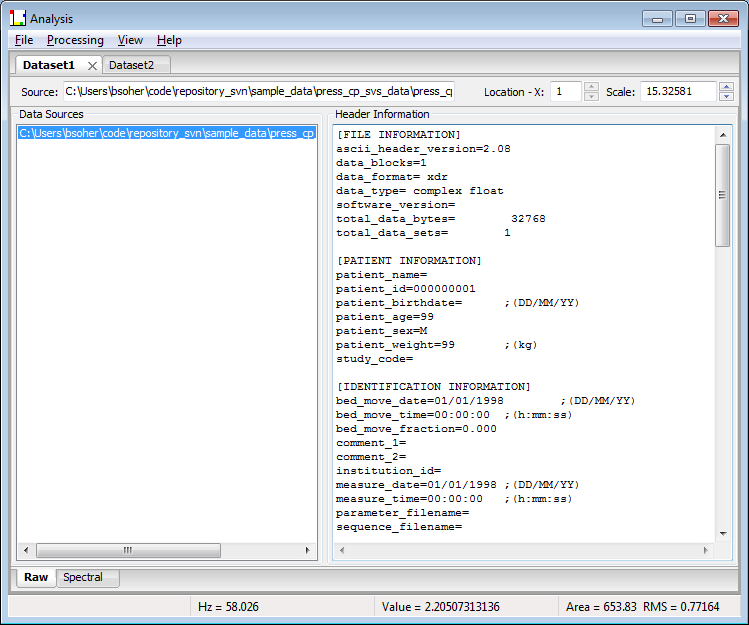
Standard raw data formats can typically be loaded as one or more files. If multiple files are selected, then the data is loaded "into the screen" and you can move navigate through the stack of SVS data using the Location–X widget (top right). The filenames of all the data loaded are displayed in the list on the right side of the workflow tab. When you click on a filename, the corresponding header information for that file is displayed in the text box on the right side of the workflow tab.
Plot Information: There is NO plot in this tab because there are no processing steps. (Note. The raw data can typically be viewed in the Spectral tab by turning off all processing and scaling the plot to display the FID data)
3.2.1 On the Standard Raw Data Workflow Tab
-
Filenames - (list select) list of filenames for the one or more SVS data files loaded into this dataset.
-
Header information - (text box) header data for the filename selected in the Filenames list. When there are more than one data sets loaded, you should be able to click on each filename and see the header information updated for each dataset.
4. Workflow Tab – Preprocess
4.1 General
When a Dataset Tab is added to the Notebook, it automatically has two Workflow Tabs added to it called Raw and Spectral. The Raw tab contains only information about the data that was imported into the Analysis program. The Spectral tab allows the user to manually adjust and visualize the time and spectral data. But, it assumes that the data coming into the Spectral tab is the ‘summed' FID time data.
When SVS data is acquired as individual FIDs and/or individual coils, it is necessary to pre-process the Raw data into the ‘summed' FID time data format for it to be processed by the Spectral workflow tab. This may include: coil combination, data exclusion, summation of individual FIDs from a single file or from multiple files and/or frequency shift or zero order phase corrections for each FID to optimize the summed data. These processing step(s) occur in the Preprocess Workflow Tab.
Note 1: Analysis tries to intelligently populate the Preprocess tab with only the methods that are possible for the data in the dataset. It tests the dimensionality of the dataset provided to achieve this. For example, if the ‘coil' dimension in the dataset has a value of 1, then the coil combine options in the Preprocess tab are turned off. Similarly, for the ‘fids' dimension and the data exclusion and corrections options.
Note 2: At this time, it is not possible to load multiple sets of SVS data into Analysis that also each have multiple FIDs that need preprocessing. This is because you usually have to select multiple files, each of which contains one FID to be summed for the overall SVS data set. So, it would be unclear which files were FIDs to be summed and which files were part of the next SVS data set. Thus, for ‘summed FID' data sets, there will only ever be one value in the Location – X widget, ie. one set of data loaded into the Dataset Tab. However, it is still possible for you to open multiple Dataset Tabs, each of which contains a single ‘summed FID' data set to make it easier for you to compare data side-by-side.
4.2 Preprocess Tab – Creating the Summed FID
Processing Control Panels: The left panel of the Preprocess tab displays widget control sections for performing: coil combination, data exclusion and FID correction and averaging. One or more of these sections may be grayed out depending on the type of data loaded.
Plot Displays: The Preprocess tab contains four plots, two spectral (for the individual and summed FID spectra) and two general X-Y plots (for displaying spectral group and user defined, data). The middle spectrum plot displays data from a single FID, as selected by the FID index control. Peak shift and phase 0 values are updated in their controls as you change this index. The bottom spectrum plot is the sum of all FIDs with the peak shift and phase 0 corrections applied as they are currently calculated. Mouse controls in the plot for right/left mouse buttons (zoom and reference cursors) act as described in Section 2.4, except that phase events are a bit more complex. The top right plot shows the alignment of all FIDs in a pseudo-2D waterfall plot. And the top right plot can be used to show the values for all FIDs of the first point in the FID, the calculated B0 shift values, or the calculated phase 0 values.
Right Button Phase Events – Phase 0 is only applied to correct individual FID data, but a ‘global' Phase 1 can be applied to correct the summed FID data.
-
Phase events are only active in the two (spectral) plots in the middle and bottom of the screen.
-
Top Spectrum Plot Phase 0 – Pressing the right button and moving up/down will change the Phase 0 correction for (only) the FID currently displayed. The value in the Phase 0 widget will have phase added/subtracted to it as the mouse moves and the spectrum in the top plot will update interactively. Note. You might also see a small change to the summed FID plot as well as the individual FID is added to the summed result.
-
Bottom Spectrum Plot Phase 0 – Pressing the right button and moving up/down will change the Phase 0 correction values for ALL FIDs globally. Phase is added/subtracted interactively and both the top and middle spectra will update as will the value in the Phase 0 widget. If you click through FIDs using the FID index widget, you will see the global phase 0 changes in each voxel reflected in the values of the Phase 0 widget as it is updated.
-
Both Plots Phase 1 – Pressing the middle button and moving left/right in either plot will change the Phase 1 correction for only the summed FID in the middle plot. Note if "Zero Phase 1" box is checked, the mouse can not be used to change Phase 1 values.
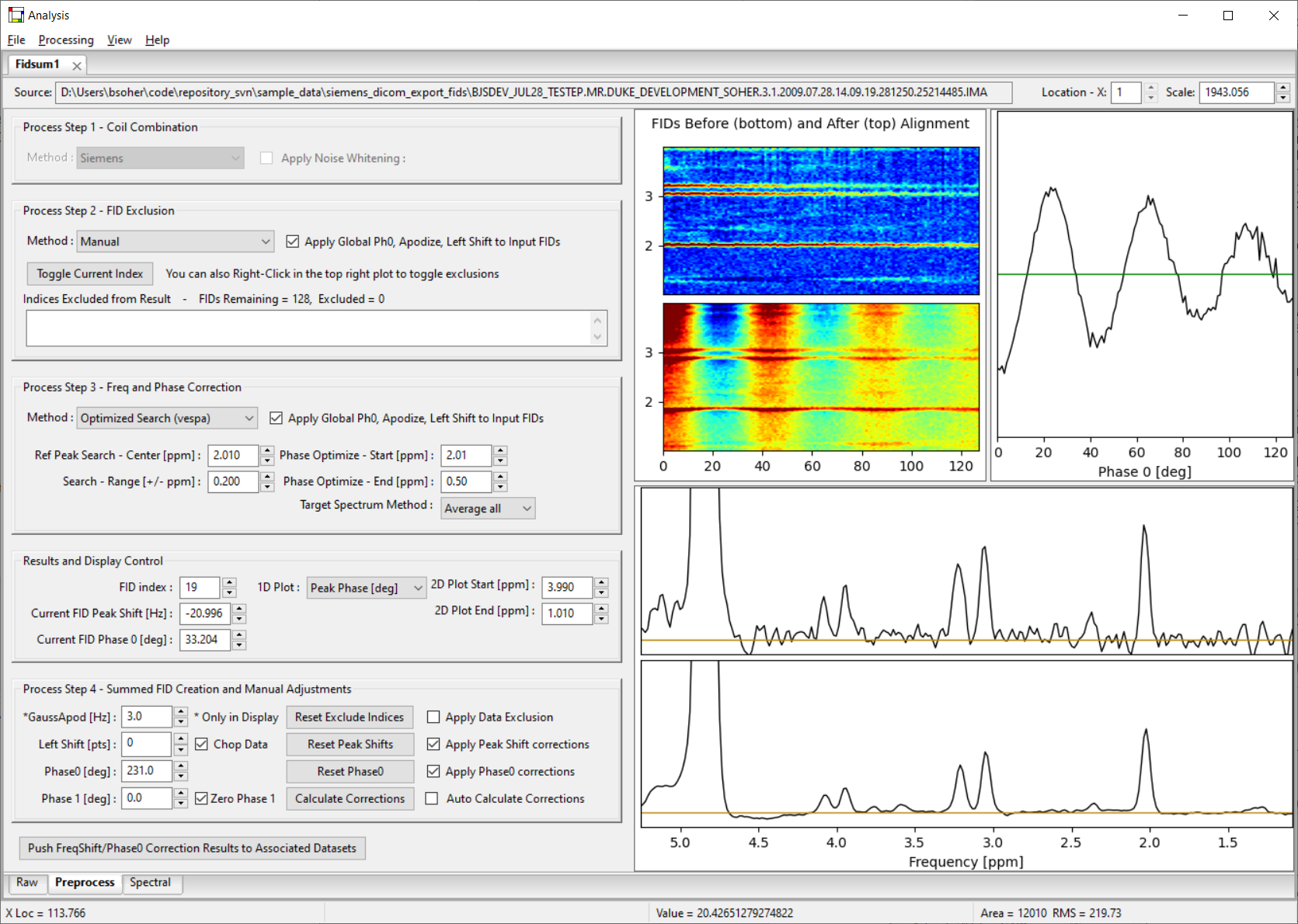
Peak shift and phase 0 values can be edited manually in the control panel. In both cases, the individual and summed FID plots is updated after values are changed.
Note. In the Figure above, the dataset did not have separate data for each coil, and the coil combine panel is grayed out. Also note the red dots in the bottom plot that show the data to be excluded from the final summed FID calculation.
4.2.1 On the Preprocess Workflow Tab
-
Coil Combine Method - (drop list) Selects the algorithm used to combine coil data. Siemens is as per IceSpectro code. CMRR methods are courtesy of Dinesh Deelschand. SVD method is based on the Suspect package. All use information from the first one or more points of the FID to estimate combination phase and weights.
-
Apply Data Exclusion - (check) Data exclusion allows the user to remove individual FIDs manually from the final summed FID result. This checkbox turns Data Exclusion functionality on/off. If off, even if parameters change in the control area, they are not applied to summed FID calculation. Data to be removed are indicated by FID index in the text field below the check box. In Manual control, users can add/remove indices using the ‘Toggle Current Index' button or interactively on the top right plot by clicking the right mouse button at the index to be removed. FID indices to be removed are displayed with red circles over them. The "Remove Xx Averages" methods are based on the FID-A package.
-
Toggle Current Index - (button) Adds or removes a FID from the exclusion list. If index is already in list, it is removed. If not in list, it is added.
-
Clear All Indices - (button) Data exclusion allows the user to remove individual FIDs manually from the final summed FID result. This checkbox turns Data Exclusion functionality on/off. If off, even if parameters change in the control area, they are not applied to summed FID calculation.
-
Plot Display - (drop list) Controls the data shown in the bottom plot. Selections include "FID Abs First Point", "Peak Shift [Hz]" and "Phase 0 [deg]". These values are plotted as an X-Y plot with the x-axis being the FID index and Y value as selected in this list. You can change back and forth in this plot without losing current settings. Note. Phase and Shift values may all be zero if they have not yet been calculated.
-
FID index - (spin control) Selects the index of the FID data to display in the top plot. This is also the index of the data whose peaks shift and phase 0 values are displayed in the respective widgets below.
-
GaussApod [Hz] - (spin control) Controls the width of the Gaussian apodization function that is applied to the data shown in the plots. This apodization value is also used in the peak search routine. The apodization applied in this tab is NOT applied to the final summed FID that is used by subsequent workflow tabs. It is only applied in the Raw workflow tab to improve data visualization by the user.
-
Left Shift [pts] - (spin control) Controls number of points dropped from the beginning of the FID data. To maintain the total number of points, the last data point is repeated.
-
Peak shift [Hz] - (spin control) Each FID data set has a separate value for peak shift. This control lets you set the shift value in Hz for the FID index data set displayed. It is updated as you click through the different FID data.
-
Phase0 [deg] - (spin control) Each FID data set has a separate value for phase 0. This control lets you set the phase 0 value in degrees for the FID index data set displayed. It is updated as you click through the different FID data.
-
Global Phase 1 [deg] - (spin control) A Phase 1 value can be applied to the middle plot of the summed FID data to improve visualization of the summed FID. This control lets you set the phase 1 value in degrees. Phase 1 IS APPLIED to the final summed FID result sent to the Spectral tab.
-
Apply peak shift - (check) Sets a flag off/on to indicate if the Peak Shift correction algorithm should be applied. Changing this control does not trigger the calculation for this correction.
-
Reset Peak Shifts - (button) Sets all peak shift values for all FID data sets to 0. This action is reflected immediately in the other controls and plots.
-
Ref peak center [ppm] - (spin control) Controls the value of the reference peak around which the peak shift algorithm searches for a maximum value in the magnitude data.
-
Peak search width [ppm] - (spin control) Controls the width of the search region around the reference peak in which the peak shift algorithm searches for a maximum value in the magnitude data.
-
Apply phase 0 - (check) Sets a flag off/on to indicate if the Phase 0 correction algorithm should be applied. Changing this control does not trigger the calculation for this correction.
-
Reset Phase0 Values - (button) Sets all phase 0t values for all FID data sets to 0. This action is reflected immediately in the other controls and plots.
-
Calculate Corrections - (button) runs the algorithms to calculate peak shift and phase 0 corrections for each FID data set in the tab. Only runs the respective algorithms if the Apply check boxes are checked.
-
Push Results to Associate Datasets - (button) this button is primarily used in ‘edited' SVS data sets like MEGA-PRESS where the raw data contains on/off states that can be processed into sum/difference states. This usually results in 4 dataset tabs being created. In theory, the Peak Shift and Phase 0 corrections for one set should be applicable equally to all datasets. This button allows you to ‘push' the current Peak and Shift values for all FIDs in this dataset to all associated datasets.
4.3 Coil Combine Algorithms
The Coil Combine panel is used to combine data from individual elements of a multi-channel receive RF coil into a single FID before the FIDs are summed into a final Summed FID result that is sent on to the Spectral Tab. The coil combine panel is only available when there are individual coil data available in the raw data set. If the ‘channel' data dimension equals 1, then the panel is grayed out.
There are three choices of algorithm for Coil Combination:
-
‘Siemens' – This algorithm is similar to that in the Siemens IceSpectroF processing pipeline. Channels are combined using weights and phases calculated within each FID acquisition, independent of other FIDs. Weights are calculated from the magnitude value of the first point of each channel's data, normalized to the root summed square of the group. Zero order phase for each channel is calculated as the normalized complex conjugate of the first data point.
-
‘CMRR' – This algorithm is courtesy of Dinesh Deelschand of the CMRR group in Minnesota. Channels are combined using weights and phases calculated from the first FID and then applied equally to all subsequent FIDs. Zero order phase for each channel is calculated as the normalized complex conjugate of the first data point. Channel weights are calculated using the numpy.polyfit() method to fit the magnitude spectrum of the first FID. The last polynomial is the zero order coefficient and thus the channel weight.
-
‘CMRR-Sequential' – This algorithm is the same as the ‘CMRR' algorithm, except that it is applied individually to each FID, independent of the others.
4.4 Data Exclusion
The Data Exclusion panel is used to remove individual FIDs from the final Summed FID result that is sent on to the Spectral Tab. The data exclusion panel is only available when there are individual FIDs available in the raw data set. If the ‘number of FIDs' data dimension equals 1, then the panel is grayed out.
Data exclusion is a manual process. The user adds or removes FID indices to a list (shown in the text field below the ‘Apply Data Exclusion check box) and during pre-processing these FIDs are excluded from the final Summed FID result. Data exclusion is only applied when the ‘Apply Data Exclusion' box is checked, regardless whether FID indices are listed in the text field.
The user can click the ‘Toggle Current Index' button to add/remove the index currently listed in the ‘FID Index' widget in the text field. If the index is not already in the text field, it is added. If it is there, it is removed. Alternatively, the user can interactively toggle indices on/off in the bottom plot on the right using the middle button while the mouse is inside the plot. The top plot (individual FID spectrum) is updated to show the FID spectrum for the index clicked on by the middle button. Note that the FID index number nearest to the mouse is listed in the status bar as the mouse moves. You can also zoom in/out to better select the FID you want.
The bottom plot displays an X-Y plot with three different types of data to help you decide if a FID should be excluded. The x-axis is always the FID index. Use the ‘Plot Display' drop list widget to select the values along the y-axis to be: 1) the absolute value of the first point of the FID, 2) the Peak Shift in Hz for the FID calculated in the Automated Data Corrections panel, or 3) the Phase 0 in degrees for the FID calculated in the Automated Data Corrections panel. Note, values in option 2 or 3 above may be all zeros if you have not performed correction calculations yet. You can switch back and forth between these three without losing the indices already marked.
The middle plot (summed FID spectrum) is updated as you toggle FID indices. You will only see this plot change if the ‘Apply Data Exclusion' box is checked. This is useful since you can slowly work through all FIDs and exclude them one by one, but at the end you can see the overall result of FID removal by clicking the ‘Apply Data Exclusion' box on/off.
For your convenience, we list the number of FIDs remaining in the Summed FID result to the right of the ‘Plot Display' widget.
4.5 Automated Data Corrections – Peak Shift and Zero Order Phase
The spectral quality of the final Summed FID result can sometimes be improved by correcting each individual FID for frequency and zero order phase errors.
This panel allows the user to control Peak Shift and Phase0 correction processing. These algorithms are only performed when the ‘Calculate Corrections' button is pressed. The user can turn each correction on/off using the ‘Apply Peak Shift' and ‘Apply Phase0' check boxes, respectively. If the box is checked, the algorithm is run and the Peak Shift and/or Phase0 results are updated. If the box is NOT checked, that algorithm is not run, but the values currently set for that variable are NOT changed either. Use the ‘Reset Peak Shifts' or ‘Reset Phase0 Values' buttons to set these values back to zero for all FIDs.
As you change the ‘FID Index' widget value, the calculated values for Peak Shift and Phase0 are updated in the ‘Peak Shift [Hz]' and ‘Phase 0 [deg]' widgets. You can also plot these values in the bottom plot as an X-Y plot for each FID index using the ‘Plot Display' drop list widget in the Data Exclusion panel.
Peak Shift Algorithm – Shifts (in Hz) are calculated relative to the reference peak and search width specified by the user. Each FID is transformed into the frequency domain and a peak search is performed in the reference peak +/- search width region of the magnitude data for the max peak. This correction is applied (if turned on) prior to Phase0 corrections.
Phase0 Algorithm – Zero order phase corrections (in degrees) are calculated relative to a ‘standardized' frequency spectrum created by summing all FIDs and transforming this into the frequency domain. If Shift corrections are calculated already, these are applied to this step as well. Phase 0 corrections for each FID are optimized to maximize a correlation function of the phased individual FID to the ‘standardized' spectrum in the range specified by the user. Note, that if the phase of the peak(s) in the user defined region do not show an absorption spectrum, then the resultant corrected FIDs will not either.
5. Workflow Tab – Spectral
5.1 General
When a Dataset Tab is added to the Notebook, it automatically has two Workflow Tabs added to it called Raw and Spectral. The top line of controls includes (as in all Workflow Tabs) the filename of the displayed data, the x-voxel index, and the y-scale of the plot in the workflow tab. You can step through each spectrum in the dataset by increasing or decreasing the index in the ‘x-voxel' widget. Parameter values specific to each spectrum are automatically updated in the widgets of each workflow tab. The y-scale on the plot can be adjusted by clicking on the arrows in the Scale control, typing in a value or using the roller ball on the mouse while in the plot.
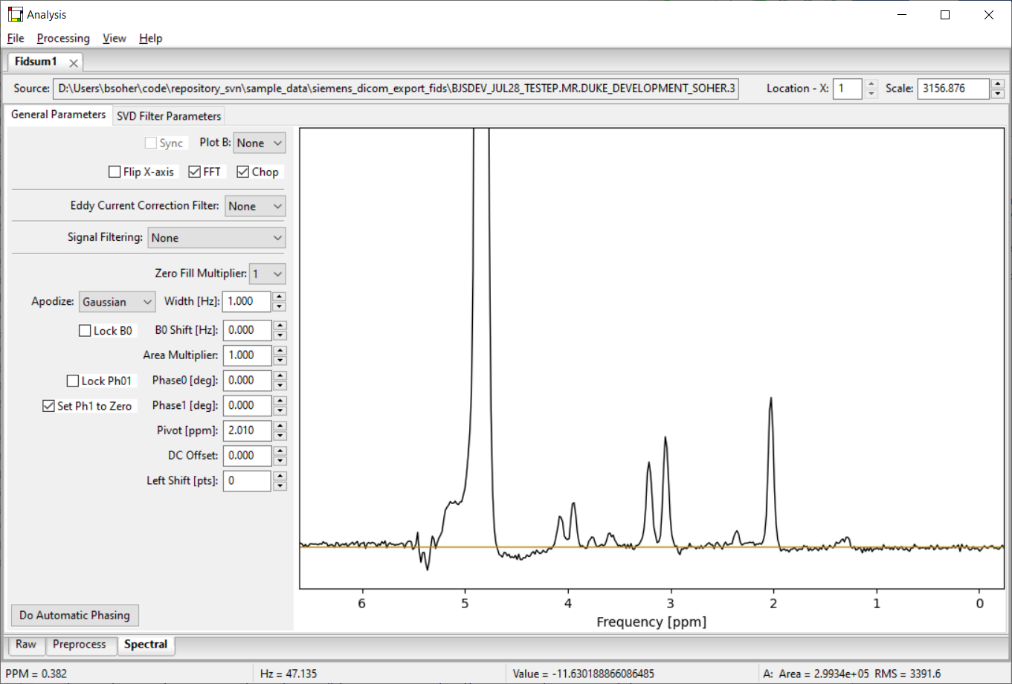
There are two workflow tabs on the Spectral Workflow Tab. They are displayed along the top edge and are called ‘General Parameters' and ‘SVD Filter Parameters'. The Spectral – General Parameters sub-tab provides controls for most of the typical processing steps involved in spectral processing including: eddy current correction, signal filtering, zero fill, signal apodization, B0 shift, zero and first order phase, first order phase pivot, DC offset, left shift and other convenience settings for interactive display of the results from changing these processing steps. Most results from changing setting in the Spectral tab are displayed in the plot windows as they are made.
As shown in this figure, the eddy current correction and signal filter controls can be set to ‘None' and have no sub-panel of controls showing. Or, a filtering method can be selected from the drop menu and a sub-panel of controls displayed for that particular algorithm. Due to the complexity of user interactions with the eddy current correction and signal filter panels, these controls are described in more detail in subsequent sections. However, due to the many possible ways of applying the results of the SVD filter, we have created an interactive sub-tab, SVD Filter Parameters, for you to use to visually examine the results of applying various results before applying them in the actual data processing.
5.2 On the Spectral – General Parameters Workflow Tab
-
Sync - (check) Flag for whether to sync changes made to the main data to whatever data is selected in the PlotB drop menu. Not all controls are bound by Sync, see wiki for more details.
-
PlotB - (drop menu) You can select a comparison dataset to plot in the middle plot (Plot B) from all the open datasets in the notebook. If None is selected, then the plot automatically reconfigures to not show Plot B. The Sync flag has no effect if None is selected. Plot B can be used to visualize simple comparisons in plot C such as A-B or B-A as set in View→Plot C Function.
-
Flip X-axis - (check) Flag for whether to flip the spectral plot along the X-axis. This value must be the same in all voxels in all datasets, thus changing it in one dataset tab will change it in all dataset tabs.
-
FFT - (check) Flag for whether to perform FFT on spectral data. May have to resize x/y axes after turning this off/on. This value must be the same in all voxels in all datasets, thus changing it in one dataset tab will change it in all dataset tabs.
-
Chop - (check) Flag for whether to apply a chop filter to the FID data prior to FFT. This will shift the data halfway along the X-axis This value must be the same in all voxels in all datasets, thus changing it in one dataset tab will change it in all dataset tabs.
-
Eddy Current Filter - (drop menu) Selects the filter used to correct for eddy currents. See section below for more details. Same method for all voxels.
-
Signal Filtering - (drop menu) Selects the filter used to correct for unwanted water and other signals. See section below for more details. Same method for all voxels.
-
Zero Fill Multiplier - (drop menu) You can select to zero fill up to 32 times the raw data size. This value must be the same in all voxels in all datasets, thus changing it in one dataset tab will change it in all dataset tabs.
-
Apodize - (drop menu) Selects apodization filter to apply [None, Gaussian, Lorentzian]. Same value for all voxels.
-
Width [Hz] - (spin control) Width of the selected apodization filter. Same value for all voxels.
-
B0 Shift [Hz] - (spin control) Control to perform phase roll on FID prior to FFT, effectively shifts frequency data either left or right by any amount. Value can vary for each voxel.
-
Area Multiplier - (spin control) Control to scale FID FFT by some floating point amount. Same value for all voxels.
-
Phase0 [deg] - (spin control) Control to set phase 0 for the displayed data plot. Value can vary for each voxel.
-
Phase1 [deg] - (spin control) Control to set phase 1 for the displayed data plot. Value can vary for each voxel.
-
Pivot [ppm] - (spin control) Control to set phase 1 pivot value. This value must be the same in all voxels in all datasets, thus changing it in one dataset tab will change it in all dataset tabs.
-
DC Offset - (spin control) Control to set phase 1 pivot value. Same value for all voxels.
-
Left Shift [pts] - (spin control) Control the number of points dropped from the front of the FID data before FFT. To maintain the same number of points, the last data point is repeated. Same value for all voxels.
-
Correct Phase 1 - (check) When the number of left shift points are known, a time varying phase roll can be applied to the data to correct for the phase 1 added by dropping points.
-
Do Automatic Phasing - (button) Performs automatic set of Phase 0 value.
The Lock B0 and Lock Ph01 check boxes allow these parameters to be changed simultaneously of all data that has been loaded "into the screen" in the main dataset (in Plot A). With Lock off, the B0 Shift and Phase0/1 changes (in widgets or by mouse) are applied only to the active voxel (shown in the plot). With Lock on, all parameter values are changed by whatever delta is applied to the active voxel.
Checking Sync synchronizes values between Plot A and Plot B. Only Frequency Shift, Phase 0 and Phase 1 are synchronized using the Sync option. Parameters in the comparison dataset are changed by the delta of the value being changed in the main dataset.
5.3 Mouse Events in the General Parameters Plot
The Spectral workflow tab may have one, two or three axes drawn. We will typically refer to these as top, middle and bottom plots, OR as Plot A, Plot B and Plot C respectively.
Most mouse events in the plot are as described above in Section 2.4. However, one difference is that when an interactive phase 0/1 event (right mouse click and drag) starts within Plot B, then the phase of the dataset shown in Plot B is changed, not that for the main dataset (Plot A). To change the phase of the main dataset, start the interactive phase event within Plot A. If the Sync box is checked both plots will be phased. If an interactive phase event starts within Plot C, no phase changes will be made.
5.4 Eddy Current Correction Control
The eddy current correction drop menu can be set to ‘None' and have no sub-panel of controls showing. Or, a filtering method can be selected from the drop menu and a sub-panel of controls displayed for that particular algorithm. The main Spectral panel automatically reconfigures itself to accommodate any additional controls. Note. Widgets near the bottom of the main panel may be pushed below the visible edge of the tab when an ECC filter panel is opened.
All of the following filters (except where noted) require a lineshape FID to use as a reference to correct the main dataset. This reference must already be loaded into a dataset in the notebook. When a filter is selected, the Browse Dataset button is displayed. This allows you to select a dataset from a list of open Datasets to use as a reference in the algorithm.
The following ECC filters are provided as part of the Analysis application:
Klose – based on the paper by Klose (MRM 14, p.26-30, 1990). This method simply subtracts the phase of the reference from the phase of the data. However, this correction only partially restores the Lorentzian lineshape since only B0(t) distortions are corrected
Quality – based on the paper by deGraaf et.al. (MRM 13, p.343-357, 1990). Performs a simple division of the main data by reference dataset. This method can cause artifacts where the denominator in the complex division is too close to zero. Strong apodization can reduce these artifacts, but broaden the effective lineshape.
QUECC – based on the paper by Bartha et.al. (MRM 44, p.641-645, 2000). A combination of both the Quality and Klose's ECC algorithms, this method preserves the strengths of each while overcoming their respective limitations. The main limitation in this filter is that a crossover point between the two methods must be selected. At the moment, this is hard coded.
Simple – variation on the Quality method. This algorithm takes the reference dataset and optimizes a frequency shift to best position the reference signal on-resonance. This simplifies the signal decay to look more like a Gaussian shape, with fewer zero crossings and thus less chance for an artifact to occur. B0 shifts in the main dataset are not corrected for by the method. Strong apodization can reduce any remaining artifacts, but broaden the effective lineshape.
Traff – developed by Jerry Matson and Lana Kaiser. Based on (Daniel D. Traficante, Masoumeh Rajabzadeh. Optimum window function for sensitivity enhancement of NMR signals. Concepts in Magnetic Resonance, 12(2): p83-101, 2000). (from Karl) The idea is to enhance S/N without sacrificing resolution - works great if the lines are Lorentzian, ergo preprocessing via reference deconvolution. Similar to the QUECC method, however it determines the cross-over point automatically based on an estimate of signal T2 decay. Also, a Traf filter is applied to the data after the reference signal has been deconvolved in order to restore a Gaussian lineshape. Typically, no additional apodization is necessary.
5.5 Signal Filtering Control
The signal filter drop menu can be set to ‘None' and have no sub-panel of controls showing. Or, a filtering method can be selected from the drop menu and a sub-panel of controls displayed for that particular algorithm. The main Spectral panel automatically reconfigures itself to accommodate any additional controls. Note. Widgets near the bottom of the main panel may be pushed below the visible edge of the tab when a signal filter panel is opened.
The following signal filters are provided as part of the Analysis application:
FIR – the raw FID data is convolved by a finite impulse response filter to remove high frequency signals (ie. Non-water signals). This low-pass signal is subtracted from the original to remove the water. The FIR kernel is calculated by the scipy.signal.firwin algorithm based on the filter length, half width, and ripple controls. Because the kernel performs poorly at the beginning of the FID, you can choose to extrapolate these values using a linear model using the Extrapolation drop menu. At the moment, the AR Model method does not work.
Hamming – the raw FID data is convolved by a Hamming filter to remove high frequency signals (ie. Non-water signals). This low-pass signal is subtracted from the original to remove the water. The FIR kernel is calculated by the numpy.hamming algorithm based on the filter length control. Because the kernel performs poorly at the beginning of the FID, you can choose to extrapolate these values using a linear model using the Extrapolation drop menu. At the moment, the AR Model method does not work.
SVD Filter – This method is a black-box estimation of the time domain FID using a model composed of summed Lorentzian lines. A Hankel-Lanczos singular value decomposition of the FID signal onto this model is performed. Subsequently, the subset of model signals that correspond to the water signals to be removed are summed and subtracted from the original signal.
Note the results and all user interactions for this filter take place on the Spectral – SVD Filter Parameters sub-tab. To apply SVD results you select this option from the Signal Filtering drop list. Then on the SVD Filter Parameters sub-tab select which signal model peaks to remove. When you switch back to the Spectral – General Parameters tab, you will see that the filtering has been applied with the selected lines.
5.6 On the Spectral – SVD Filter Parameters Sub-tab
The SVD Filter Parameters sub-tab is always active in each Spectral workflow tab. This sub-tab allows you to set the input parameters for the HLSVDPro algorithm and visualize the results and compare them to the original spectrum.
As in the General Parameters sub-tab, the top line of controls are still visible and includes the filename of the displayed data, the Location-X index, and the y-scale of the plot. You can step through each spectrum in the dataset by increasing or decreasing the index in the ‘Location-X' widget. Parameter values specific to each spectrum are automatically updated in the widgets of each workflow tab. The y-scale on the plot can be adjusted by clicking on the arrows in the Scale control, typing in a value or using the roller ball on the mouse while in the plot.
The algorithm is run for the active voxel as the you click on the Location-X widget. If the voxel has already been run once, and the input parameters have not changed, then the algorithm is not run, rather the current results are displayed in the plot.
Each voxel can have different settings for the HLSVDPro algorithm. These default to typical values but can be set by navigating to the desired voxel (via the Location-X widget) and setting the widgets in the left panel. Most results from changing HLSVDPro parameters or results widgets are reflected in the widgets and plots within a few seconds.
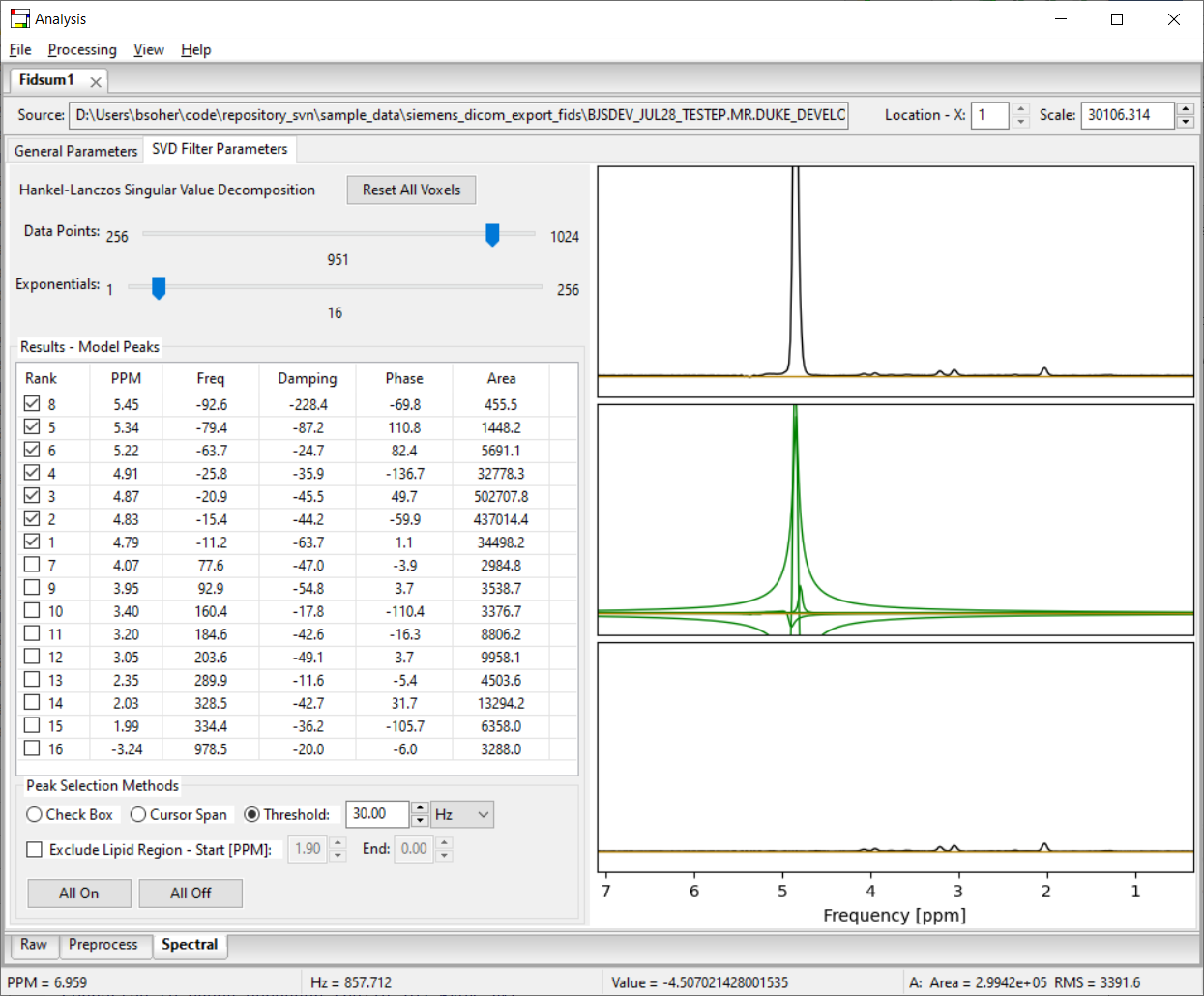
You can sort the results by clicking on the column labels in the Results table. Clicking more than once on the same label will sort by either ascending or descending order. Note, the "Rank" column indicates the order that the model signals were returned from the HLSVDPro algorithm. This order is based on the scale of the singular value for that line and is ordered from largest to smallest singular value for rank values 1 to N respectively.
The processing in the SVD sub-tab is based on the HLSVDPro algorithm from the paper by Laudadio (JMR 157, p. 292-7, 2002) which is an extension of the HLSVD algorithm presented in the paper by Pijnappel (JMR 97, p.122-134, 1992) The code for both algorithms were kindly contributed by the jMRUI project (http://sermn02.uab.es/mrui/). The HLSVD algorithm was replaced by the HLSVDPro algorithm in Vespa-Analysis from version 0.5.0 onward.
-
Reset All Voxels - (button) Sets algorithm input values back to default values for all voxels.
-
Data Pts - (slider) number of data points of the FID to use in the calculation. May not be more than the spectral points in the raw data.
-
Exponentials - (slider) Integer between 1 and 50 for number of exponential lines allowed in model.
-
Results Model Peaks - (check matrix) This matrix acts similarly to a spreadsheet. Column widths can be adjusted. Rows can be sorted by a particular column by clicking on the column label. The HLSVDPro algorithm returns a frequency, phase, area and damping term for each exponential line in the model. We provide a conversion of frequency to ppm for convenience. You can add lines to be plotted (and used by manual setting in the HLSVD water filter) by checking the box at the left of each row. You can use the "All On" and "All Off" buttons to set/reset all check boxes at once.
-
Peak Selection Methods - This section provides a number of ways to select model peaks to remove from the data.
-
All On - (button) Checks all boxes in all rows in the results matrix.
-
All Off - (button) Unchecks all boxes in all rows in the results matrix.
-
Check Box - (radio box) does not actively change any peak selections. Just indicates that you can manually turn check boxes on/off by clicking on them. You may also do this while cursor span is selected, too, but no manual selection can be done under threshold.
-
Use Cursor Span - (radio box) When this box is checked and the you draw a cursor span (right mouse click and drag) the tab calculates all model peaks that are within the PPM range of the span and check their boxes in the results list. Checks are additive in that the next cursor span you draw does not turn off any check boxes, it just checks any additional lines in the new span. Use the "All Off" button to start over.
-
Threshold [Hz] - (radio box) When this box is selected, all check boxes are set off, then only the peak results whose frequency values are at or below the threshold amount (spin control to right) are set on. This option is de-selected when you click manually on a peak's box. The threshold value works in conjunction with the frequency shift value set in the General Parameters sub-tab. Because the SVD is applied before the data is shifted, the cumulative effect is as if the threshold was equal to the threshold minus the frequency shift value. This can be seen visually in the plot, but is not reflected in the peak frequencies or threshold widget, itself.
-
5.7 Mouse Events in the Spectral – SVD Filter Parameters Plot
The SVD Filtering Parameters sub-tab has a plot that always has three axes drawn. We will typically refer to these as top, middle and bottom plots. The top plot displays the dataset without any water filtering. The middle plot displays an overlay plot of green lines of all the model results that are checked. The bottom plot displays the middle (results) plot subtracted from the top (data) plot.
Most mouse events in the plot are as described above in Section 2.4.
6. Workflow Tab – Fitting
6.1 Fitting Method – Voigt
This workflow tab allows you to estimate metabolite signal contributions within your data while accounting for nuisance signals such as unsuppressed water, lipids and macromolecular resonances. The Fitting workflow tab makes use of algorithm we call the Voigt method.
6.1.1 Background and General Algorithm
The Voigt method and is based on the papers by Young, Soher, et.al. :
-
Young K, Soher BJ and Maudsley AA. Automated Spectral Analysis II: Application of Wavelet Shrinkage for Characterization of Non-Parameterized Signals. Magnetic Resonance in Medicine; 40:816-821 (1998)
-
Soher BJ, Young K, Govindaraju V and Maudsley AA. Automated Spectral Analysis III: Application to in Vivo Proton MR Spectroscopy and Spectroscopic Imaging. Magnetic Resonance in Medicine; 40:822-831 (1998)
The Voigt method is an automated spectral analysis procedure that combines a parametric model of signals of interest with a non-parametric characterization of the unknown signal components. A least-squares fit, using a priori knowledge of the MR observable compounds (from Vespa-Simulation results), is first used to create a parametric model that is optimized to the known spectral contributions (spectrum minus baseline signal estimate) in the MR signal. This is then followed by a wavelet filtering of the residual data signal (spectrum minus metabolite signal estimate) to characterize the so-called baseline contributions. Use of wavelets allows us to dial in the scale of features in the baseline estimate to be more slowly changing than the more narrow signals in metabolite model. The repeated application of these operations rapidly converges to obtain an optimum fit of both signal components.
These features are used in the iterative procedure described below. Each step above is explained in more detail below, but first let's look at an outline of the procedure itself.
Iterative Algorithm for Fitting
-
Initial spectral parameter estimation from raw data, and formation of a model spectrum
-
Subtraction of the spectral model from a copy of the raw data
-
Baseline characterization using the wavelet filtering procedure
-
Subtraction of the baseline characterization from a copy of the raw data
-
Spectral parameter optimization of the metabolite model (create spectral model for next iteration)
-
Repeat (2) – (5) for N iterations
Voigt Model Starting Values
The best fitting results occur when voxels are already corrected for B0 shifts and zero and first order phase in the Spectral workflow tab. A priori metabolite knowledge is very useful for determining the initial starting values for frequency, B0 shift, zero and first order phase, and line width; however, at the moment all of these value are set manually within the parameter panels of the Fitting workflow tab.
Voigt Model a Priori Information
The Voigt model uses a priori information selected from Experiments stored in the Vespa data base to create a metabolite basis set. It is very important that the Experiment used to build the basis set be matched to the actual pulse sequence used to acquire the data. Metabolite resonance patterns in an Experiment are described as collections of individual resonances, with relative amplitude, frequency, and phase values for each line in the pattern.
Parametric Model of Metabolite Signal Contributions
For complete characterization of each metabolite in the data to be analyzed, only two additional parameters were required beyond the metabolite database, an amplitude multiplier, and frequency shift value. The complete parametric model used for the metabolite portion of the signal is shown below.
The metabolite portion of the spectrum is modeled as the sum of decaying sinusoids over time t, Fourier transformed into the frequency domain. Terms indexed over Nm comprise the a priori information describing the resonances structures for each metabolite, with amplitude, An, ωn, and phase, φn, that do not change in the course of the analysis. Terms indexed over m parameterize the metabolite signals in the spectrum being analyzed, with each metabolite modified by amplitude scale Am, and frequency shift adjustment term ωm.
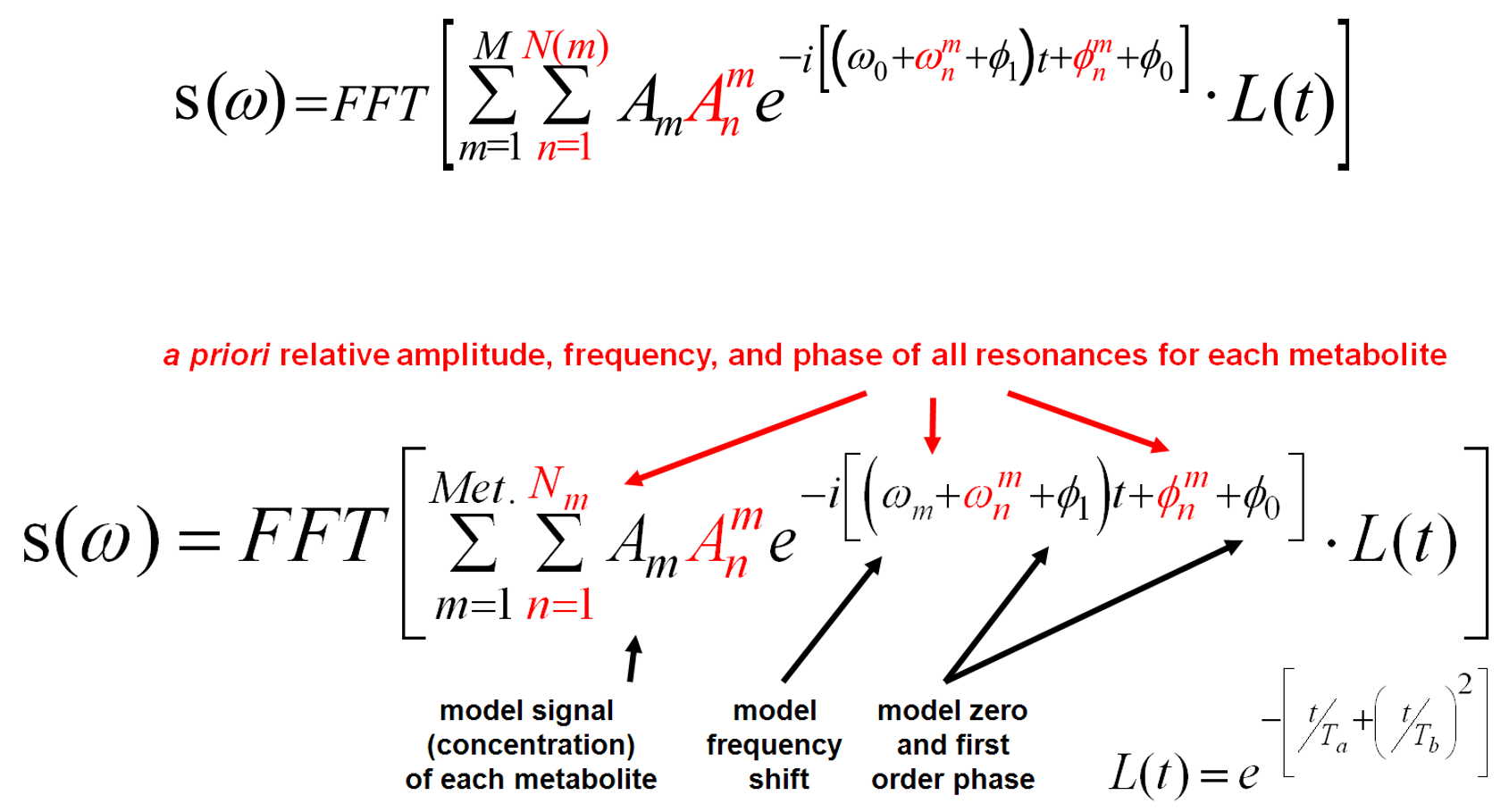
Zero and first order phase terms, φ0 and φ1, are applied globally to the spectral data. And, in the standard fitting methodology, the lineshape for each metabolite is parameterized using two decay constants, Ta and Tb , in the in L(t) function to describe a Voigt (Lorentz-Gauss) model.
By making use of all available spectral information for each metabolite, the procedure is better able to separate contributions from overlapping multiplets, while also using maximum available signal energy. In addition, by defining a fixed relationship between all resonances for each compound, the model above is greatly simplified and the number of parameters is minimized.
6.2 Voigt Fitting Workflow Tab
The Voigt Fitting workflow tab has a top line of controls that includes (as in all workflow tabs):
-
Source - (text) the filename of the displayed data. If multiple files were read into the dataset, this may represent the name of the file currently displayed by the Location-X setting. It may or ma not represent the name that the dataset was saved to using the File->Save menu item, since it is the filename of the Source data, not the processed data filename.
-
Location – X - (spin control) If more than one spectral data set is loaded into the current Dataset, this widget allows you to step through them in the display. Use the up/down arrows, or type in a number, or click in the display box and scroll with the wheel on your mouse.
-
Scale - (spin control) The y-scale on the plot can be adjusted by clicking on the arrows in the Scale control, typing in a value or using the roller ball on the mouse while in the plot.
An example of a fitted MEGA-PRESS DIFFERENCE spectrum is shown in the figure below with the results tab displayed.
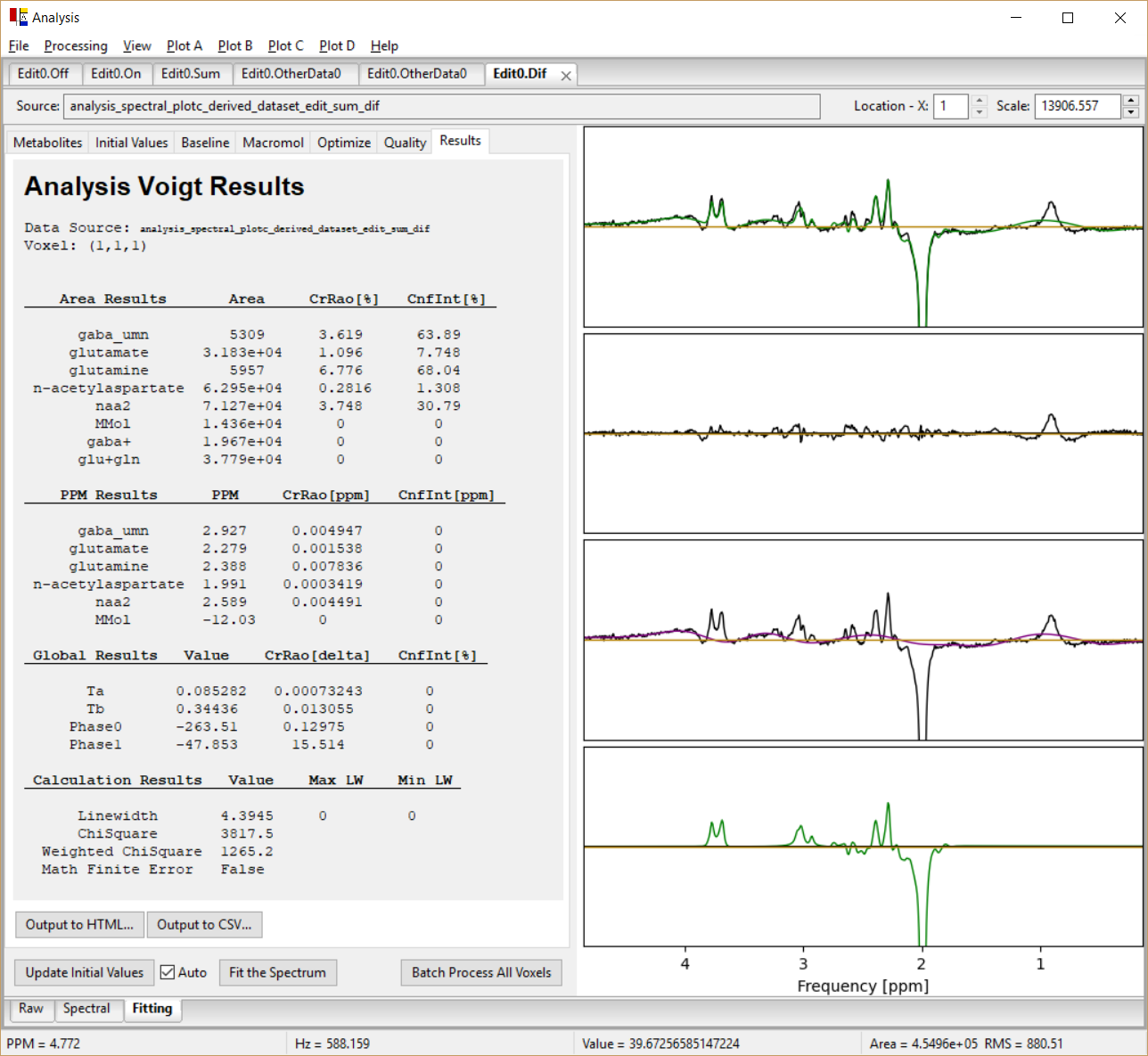
There are also three buttons and a check box along the bottom of the tab just above the ‘Fitting' tab itself. These are visible regardless which Fitting workflow tab is selected.
-
Update Initial Values - (button) Most initial value parameter changes are automatically reflected on the plot. This button allows you to force a recalculation of these values.
-
Auto - (check) When on, any widget change will trigger update of values in the plot. When off, user much push "Update" button to trigger plot changes. Turn auto update off if you want to change a lot of subtab values and don't want to wait for each one to process/display.
-
Fit the Spectrum - (button) Triggers a fit of the data using the current set of parameters. Progress messages about the various steps of the fitting process are displayed in the status bar. Plots and the Results tab are updated automatically at the end of each fit.
-
Batch Fit All Voxels - (button) Triggers a fit of all voxels as if you had manually clicked to each Location-X setting and hit the ‘Fit the Spectrum' button. Progress messages about the various steps of the fitting process are displayed in the status bar.
6.2.1 On the Menu Bar
There are some additional menu items on the Fitting tab not available on other tabs.
-
View→NumberOfPlots - The Fitting workflow tab can display between one and four axes drawn in the plot panel to the right. These are typically referred to as Plots A through D. The plot number is set in the View menu. Each of the four plots has its own control menu in the menu bar.
-
Plot A (B, C, D)→Plot Type - There are 14 different plot types that can be displayed. For example, in the figure above, Plot A shows "Raw and InitialModel", Plot B shows "Raw and Base" , Plot C shows "Raw and (Fit+Base)" and Plot D shows "Raw-Fit-Base" or the residual spectrum.
-
Plot A (B, C, D)→Data Type - Data shown in each plot can be Real, Imaginary or Complex. If the data in the plot consists of 2 or more summed contributions (such as metabolite bases in the fitted data result) you can select to see that result as either Summed or Individual plots.
See Section 2.2 for a review of the other menu bar commands and selections that affect the plots and output options.
6.3 Mouse Events in the Plot
Most mouse events in the plot are as described above in Section 2.4.
6.4 Voigt Algorithm Parameter Control Panels
Control widgets for Voigt fitting algorithm parameters are located in a notebook whose tabs are arrayed along the top of the left hand panel. These include: Metabolites, Initial Values, Baseline, Optimize, Quality and Results. Parameter values in these tabs typically apply to all voxels. Only the results panel is updated as you navigate through the Location-X widget. The controls in each panel are described in more detail below
6.4.1 On the Metabolites Panel
On this control panel, you select the source of prior information for the metabolite model. You can also specify which metabolites are included in the spectral model and manually modify starting values.
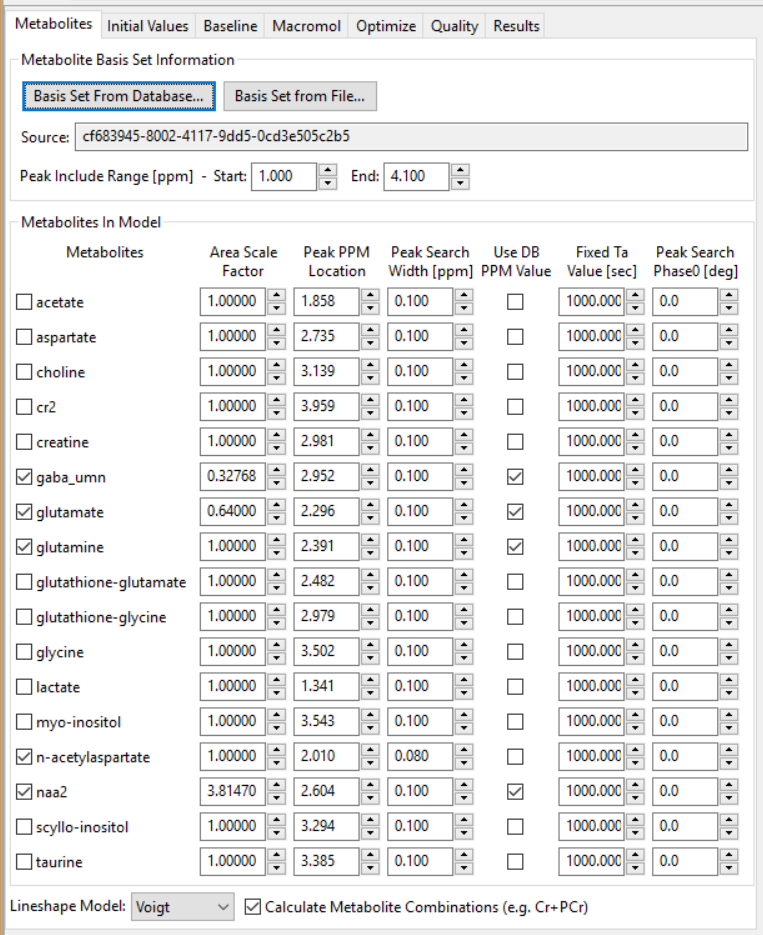
-
Prior from Database - (button) Activates a dialog from which you select a Simulation-Experiment that contains the prior information that you want to use. Then, a second dialog pops up to allow you to select which portion of the Experiment to use if it has multiple Loops in it.
-
Prior from File - (button) Activates a file select dialog to browse for an XML file that contains the prior information that you want to use. The file should have a "prior" node inside it. It can be a ‘Analysis Prior' file that was created from the Vespa-Simulation Third Party Output dialog, an Analysis ‘preset' file, or even an Analysis VIFF file in which a different processed dataset has been saved. In all cases, the ‘prior' node will be copied into memory for use in the current dataset.
-
Source - (text box) Read only. Displays the name of the prior information source.
-
Peak Include Range (spin controls) The start and end PPM values for spectral lines to be included in the metabolite model. Note. All spectral information from the prior source is read into Analysis, but can be limited to a specific range as it is used in the fitting algorithm using these widgets.
-
Dynamic Metabolite List - (list) All metabolites in the prior source are displayed in a list that resizes itself for each prior source you load. Check the box in front of each metabolite you want to include in your model. Descriptions for the other widgets associated with each metabolite are given below.
-
Lineshape Model - (drop list) You can choose to use a Voigt, Lorentzian or Gaussian line shape in your metabolite model. Note. The Voigt line shape uses two internal parameters in the model, called Ta and Tb, to simulate T2 and T2* effects on the ideal FID model. The Lorentzian and Gaussian line shapes are enforced by setting either Tb or Ta, respectively, to very large values that contribute insignificantly to the lines shape model. However, they may have some minimal effect on the eventual line shape modeled.
-
Calculate Metabolite Combinations - (check) When on, commonly combined metabolites will be calculated and added to the area results table. These will include: naa+naag, cr+pcr, gpc+pcho, cr2+pcr2, glu+gln, tau+glc, and gaba+. The original separate fitted metabolites will remain in the table as well. Combination areas will only be reported if both metabolites are listed in the metabolite model.
Settings in the Dynamic Metabolite List Widget
There are a variety of settings that are associated with each metabolite that can be set from the dynamic list. Not every setting is always applicable, but will only be used if needed. Most of these affect how the initial value routines search for starting values, but some affect the metabolite model itself.
-
Area Scale – Scale the starting peak amplitude using the Area Scale Factor widget for each metabolite (initial value routines).
-
Peak PPM Location – this widget is initially set by finding the ppm of the max value of an ideal plot of each metabolite in the basis set. The program uses this value to search for a peak on which to set the starting peak area in the initial values routine. The default value is the PPM calculated from the DB basis spectrum. You can change the region it searches for a particular metabolite peak by changing this widget (initial value routines).
-
Peak Search Width – this widget limits how far from the peak center the algorithm searches (initial value routines).
-
Use DB PPM Value – Check the box to force the initial values routines to use the max peak value calculated from the DB spectrum rather than peak search. This is the default value set in the "Peak PPM Location" widget (initial value routines).
-
Fixed Ta Value – This setting is only applied when the Gaussian line shape model is chosen. The Voigt model parameterizes Lorentzian and Gaussian model elements using the Ta and Tb parameters, respectively. To approximate a Gaussian model, the Ta parameter of the Voigt model is set to a very high fixed value making it essentially insignificant. The Fixed Ta Value widget allows you to set a smaller value that may be more physiologically relevant (metabolite model).
-
Peak Search Phase0 – The widget is used to apply zero order phase to the spectrum prior to performing a peak search. In spectra that have significant first order phase, this widget can be used to set a phase for each peak that best approximates an absorption spectrum before estimating starting values. One application is for FID data from ultrashort TE routines (UTE data). This phase value does not affect the final fitted zero order phase value (initial value routines).
Prior Information from Database Button – Using the Analysis Prior Selection Dialog
Hitting this button pops up the Experiment Browser dialog shown below. This displays all the saved Experiments that have been performed in the Vepsa-Simulation application. Select the Experiment from the list on the left that contains the prior information you want to use as a basis set and hit Open.
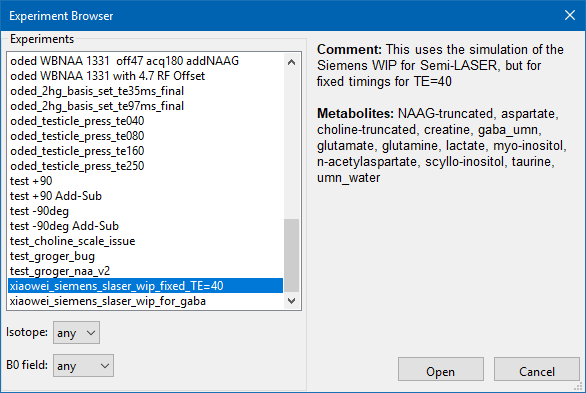
The Analysis Prior Selection dialog (shown below) will open, populated with the metabolite information from the Experiment you selected. You can now use this dialog to ‘fine tune' the format of the prior information used as your basis set. This is explained in more detail below.
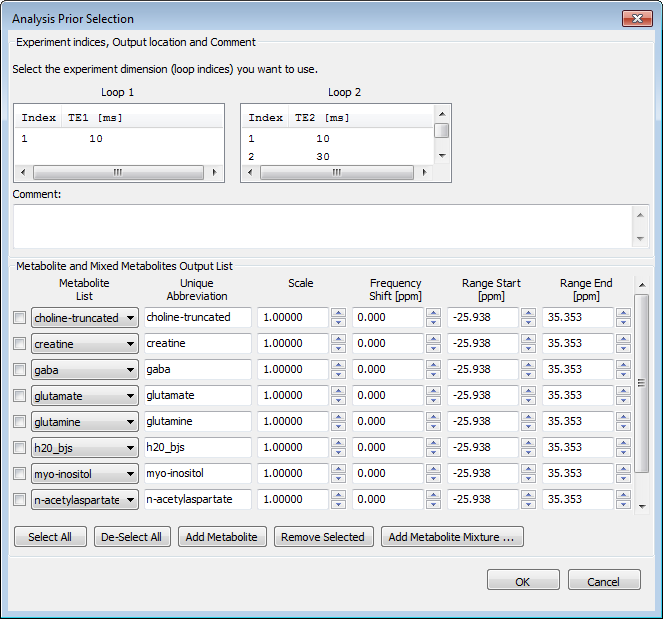
-
If the selected Experiment contains multiple simulations of each metabolite (created using one or more of the three user defined Loops in Vespa-Simulation) then you will have to use the top section of the dialog to select the one set of Loop parameters you want to use as a basis set. Whatever Loops exist, and the values they contain, will appear as scrolled list widgets in the dialog. Pick one entry in each list.
-
You can document any changes made in this dialog by typing a comment in the Comment box. This text will be preserved in XML file created when you Save the dataset.
-
This dialog allows you to modify the basis set that is imported similarly to the way a ‘Analysis Prior' file is created from the Vespa-Simulation Third Party Output dialog.
-
The name typed in the Unique Abbreviation column for each metabolite is the one that will be used internally in the Analysis Fitting tab. It will also be used in any results output, both text or image based. So, if you created an odd named metabolite in Analysis-Simulation, like ‘myCreatine_version3', and it is now shown in all its glory in the Metabolite List column in the dialog, you can rename it for the Fitting tab to ‘creatine' using the Unique Abbreviation column.
-
You can scale ‘truncated' metabolites (such as choline-truncated, that hopefully you have renamed to just ‘choline') to have the proper areas using the Scale widget. Be sure to type <return> after typing in the new value.
-
You can ‘split' metabolite resonance groups into parts by adding a copy of a metabolite and then adjusting the start and end PPM ranges for the original and the copy. Here's how to split off the 3.9 ppm peak of ‘creatine':
-
Hit Add Metabolite button, the dialog will redraw itself with a new line added to the bottom of the list of metabolites. By default, it is set to the first metabolite in the list.
-
Change this new metabolite line to ‘creatine' using the drop-down widget.
-
Type ‘cr2' into the Unique Abbreviation field.
-
Change the PPM Start/End range of the original ‘creatine' metabolite to 0.0 and 3.5, respectively. Change the ‘cr2' metabolite to have Start/End values of 3.5 and 4.5, respectively. Each of these metabolites now only contains one peak from the full ‘creatine' simulation. Again, make sure to hit <return> after changing these values.
-
-
You can add ‘metabolite mixtures' such as Glx which could be defined as a 5:1 ratio of glutamate to glutamine. Here's how to create ‘glx':
-
Hit the Add Metabolite Mixture button, the Mixed Metabolite Designer will appear. (see image below)
-
Fill in the Unique name as ‘glx'
-
Use the two drop list widgets to select ‘glutamate' and ‘glutamine'
-
Leave the ‘glutamate scale at 1.0, set ‘glutamine' scale to 0.2 for a 5:1 ratio. Note, in general I recommend leaving the ‘primary' (or larger concentration) metabolite scale at 1.0 and changing the other metabolite scale to create the needed ratio.
-
Hit OK, and the resultant mixture will appear back in the Analysis Prior Selection dialog as a new line at the bottom of the list of metabolites.
-
-
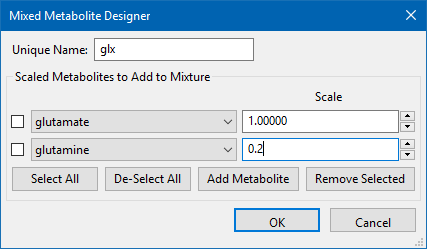
Once all additions and changes have been made, hitting the OK button sets the basis set values into the Analysis-Fitting-Metabolite tab.
Click on the Cancel button to default back to the current values in the Fitting-Metabolite tab.
6.4.2 On the Initial Values Panel
On this control panel you select the methods for calculating starting values for the Voigt model optimization. Values for each starting value are displayed in the respective section.
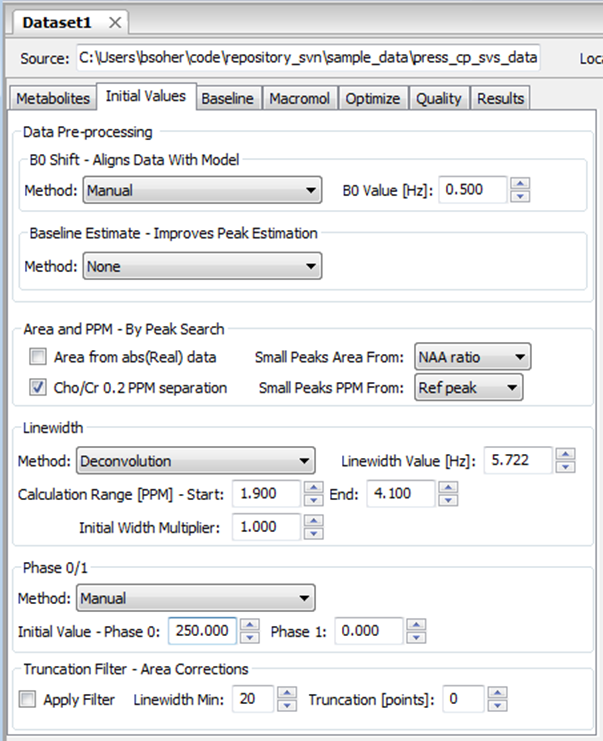
-
Data Pre-processing - These steps are performed prior to metabolite value estimation.
-
B0 Shift - (drop list, spin control) This control sets the method for B0 shift evaluation. Methods are Manual and Auto Correlate. This is the same value that is shown on the Spectral tab. Changes to this spin control will also be reflected on the Spectral tab. The Auto Correlate algorithm compares the data spectrum to the AutoPrior spectrum in the range listed on the AutoPrior panel. The offset with the highest correlation is selected as the B0 value.
-
Baseline Estimate - (drop list) This control selects the algorithm used to estimate initial baseline signals using either a Lowess or Savitzky-Golay filtering technique. Prior to the application of the filter, regions known to have metabolite peaks (from the ppm list in AutoPrior) are modified by estimating a straight line across the bottom of the metabolite peak region.
-
Peak Ignore Width - (spin control) Sets the width (in Hz) of the metabolite region that is modified prior to the filter application. The region(s) are centered on the ppm values in the AutoPrior basis set.
-
Filter Window Size - (spin control) Sets the filter window width (in Hz) used to smooth the baseline signal estimation.
-
Area and PPM - These values are obtained by a peak search and some calculations based on peak height and linewidth.
-
Area from abs(Real) - (check) Perform peak search routines on abs(Real) plot rather than the Real data plot.
-
Cho/Cr 0.2 PPM Separ. - (check) Force Cho and Cr peak PPM values to be at least 0.2 PPM apart.
-
Small peaks Area - (drop list) Select small peaks (any other than NAA, Cr, Cho) area estimation method from NAA Ratio or Peak Search. NAA ratio will use literature values to set small peak areas based on a ratio to the NAA peak area. Peak search will locate the max data value at the Peak PPM Location listed for the metabolite in the Metabolite tab and convert this peak height into an estimated area.
-
Small peaks PPM - (drop list) Select small peaks (any other than NAA, Cr, Cho) PPM estimation method from Peak Search or Reference Peak. Ref peak will use literature values to set small peak PPMs based on an offset to the NAA peak area. Peak search will locate the max data value near the Peak PPM Location and use that PPM value.
-
Linewidth - (drop list, spin control) This control sets the method for peak linewidth evaluation. Methods include Manual, Deconvolution and Auto Correlate. Deconvolution creates an ideal ‘impulse' spectrum using AutoPrior peak ppm values and performs a deconvolution on the data in the region set in the Calculation range widgets. The FWHM of the max peak in the deconvolution spectrum is used to set the linewidth value. Similarly, Auto Correlate performs an auto-correlation of the spectral region listed in the Calculation range widgets with itself. Again the FWHM of the max peak sets the linewidth value.
-
Initial width multiplier - (spin control) Used to modify the linewidth value from Deconvolution and Auto Correlate methods.
-
Phase 0/1 - (drop list, spin controls) These controls set the method for zero and first order phase values. These are the same values shown on the Spectral tab. Changes to these spin controls will also be reflected on the Spectral tab. Methods include Manual, Correlation and Integration. Both automated methods can be applied to phase 0 only or both phase 0 and 1. Automated phasing method parameters are set in the User-Defined Prior Spectrum dialog on the Processing menu.
-
Apply Truncation Filter - (check) Truncate the data FID by N points prior to doing peak search for peak heights to use in calculating starting peak areas. Algorithm used a bootstrap method to account for peak height loss due to T2* decay at N points duration.
-
Linewidth Min - (spin control) Line width estimate will affect bootstrap algorithm. This control allows the user to set a minimum line width to use.
-
Truncation [points] - (spin control) Integer number of points to lop off of the FID data array prior to the initial area estimation.
6.4.3 On the Baseline Panel
On this control panel you select the algorithm to non-parametrically estimate baseline signal contributions. Selections include wavelets, splines or none. You can also specify whether smoothing filters should be applied to the data as part of the estimation. Note. The typical Voigt model uses wavelets for baseline estimation, but spline options are included for convenience.
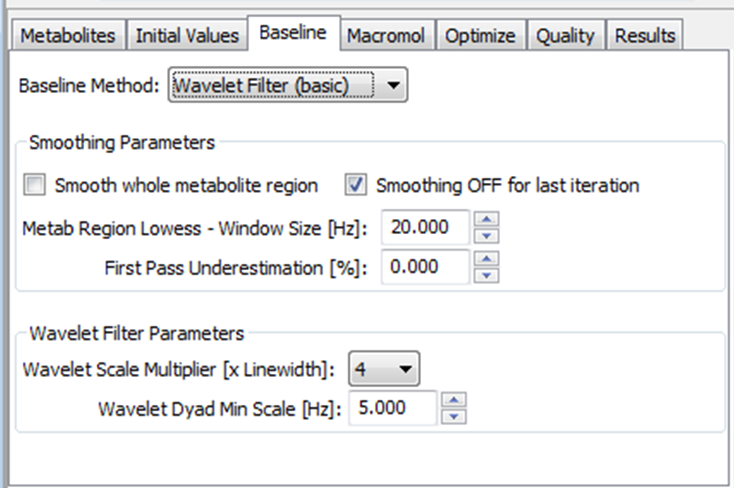
or
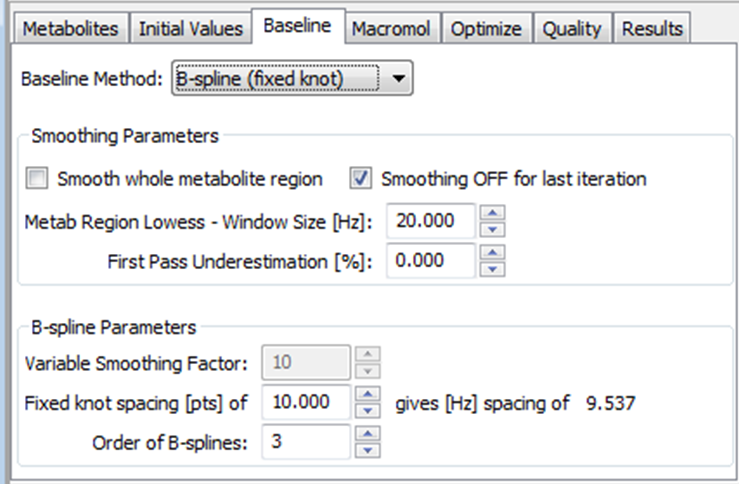
-
Baseline Method - (drop list) Options include None, Wavelet filter (basic), B-spline (fixed knot), and B-spline (variable knot). The panel below the Smoothing Parameters panel will reconfigure depending on the method selected. Note that the variable knot option can take considerably more processing time than the other two methods.
-
Smoothing Parameters
-
Smooth whole region - (check) flag, turns smoothing off/on in the metabolite region during iterations for the baseline estimation.
-
OFF for last iteration - (check) flag, turn on to NOT apply filtering to baseline on the final iteration of baseline and metabolite signals fitting.
-
Lowess window size - (spin control) float, in Hz. Window width for the lowess algorithm to estimate outliers and apply regional spline filtering.
-
First pass underest. - (spin control) float, percent. You can force the baseline signal estimation on the first pass to be more or less than the algorithm calculates. This can be useful if you know that the initial value routines for the metabolites consistently over- or under-estimates.
-
-
Wavelet Filter Parameters
-
Scale Multiplier - (drop list) integer 1-16. Wavelet contributions to the baseline are filtered to be greater than a specified threshold. This threshold is based on this widget's multiplier times the calculated metabolite signal line width. Higher values result in a smoother baseline.
-
Wavelet Dyad Min Scale - (spin control) float, Hz. Sets the minimum scale wavelet element that can be used in the baseline estimation in Hz. This value overrides the multiplier scale in the event of very narrow metabolite peaks which might result in baseline elements that change too swiftly.
-
-
B-spline Parameters
-
Smoothing Factor - (spin control) integer. Only used for Variable Knot option. Range from1-100 apply less or more smoothing of the spline estimation, respectively. See notes below.
-
Spline Spacing [pts] - (spin control) float, points. Only used for Fixed Knot option. Describes how closely knots should be spaced across the frequency domain. Number of knots depends on the sweep width and hertz-per-point.
-
Order of B-splines - (spin control) int, power value. Used in both Fixed and Variable Knot options. Polynomial power value of the splines used in the model.
-
Notes on Baseline Algorithms
Wavelets are a great way to ‘dial in' a baseline estimate that has a fixed amount of smoothness relative to a reasonable range of metabolite linewidths. That is, the baseline rate of change is fixed by the minimum dyad scale being used, which in turn is determined by some multiple of the calculated FWHM linewidth for a metabolite singlet peak. In some cases, typically when there are a few areas with very narrow linewidths, the minimum dyad scale can ‘jump' up and down leading to small but noticeable regional differences in peak areas. The Wavelet Dyad Min Scale control can be used to mitigate this effect.
Both fixed and variable spline baseline methods use the scipy.interpolate.splrep() method, which is based on the FORTRAN routine curfit from FITPACK. It finds the b-spline representation of a 1-D curve given the set of data points (x[i], y[i]) it determines a smooth spline approximation of degree k on the interval xb <= x <= xe. The fixed spline representation places knots based on the user set spacing. The farther apart the knots, generally the smoother the spline baseline estimate. The variable knot representation uses the ‘s' smoothing condition that splrep can take to determine the tradeoff between closeness of knots and smoothness of the fit. Larger s means more smoothing while smaller values of s indicate less smoothing. See scipy docs for scipy.interpolate.splrep for more details.
Note. In Analysis baseline smoothing factor widget value (for variable knot) is directly related to the ‘s' value. Generally, the allowed range of 1-100 (unit-less) is mapped internally to a semi-linear increasing value of ‘s' that was determined empirically for a variety of MRS single voxel data. In general, we only recommend the use of the variable spline baseline if the wavelet filter and fixed spline baseline routines have failed, due to the non-linear performance of this routine.
6.4.4 On the Macromol Panel
On this control panel you select a model for accounting for macromolecular signal components (at the moment, there is only one) and set the parameters for applying that model. Depending on the model chosen, different parameter panels may be displayed below the drop list.
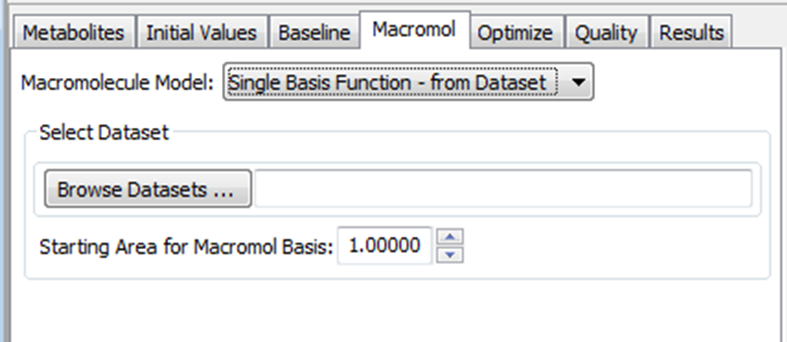
-
Macromolecule Model - (drop list) Selects the model to use to account for Macromolecular signals from None or Single Basis Function from Dataset list.
-
Model 1) Single Basis Function – from Dataset - Parameters below pertain to this model. This model uses the data from another Dataset that is open in Analysis to fit macromolecule signals in the current Dataset. The FID for the chosen macromolecular FID is used as another basis function in the fit. The data is scaled initially by the value in the ‘Starting Area' spin widget.
-
Browse Datasets - (button) This button opens a dialog that allows you to select a Dataset from a list of open datasets. This is the data that will be used as the model to fit macromolecular signals in the global fitting optimization.
-
Starting Area - (spin control) float. This is the starting value for scaling the basis function to fit the macromolecular signal contributions.
6.4.5 On the Optimize Panel
This control panel allows you select the algorithm and parameters for the optimization algorithm and set up the constraints, bounds and weights for the Metabolite model. There are two optimization algorithms, 1) LMFit (left) and 2) Constrained Levenberg-Marquardt (right), shown in the figures below.
-
LMFit allows users to set Bounds (min/max parameter values) and Constraints (aka. Soft bounds, like choline must be >0.2 ppm apart) on the optimization.
-
Constrained Levenberg-Marquardt only lets users set Bounds. This method can run more quickly than LMFit, but may require tighter bounds to perform equally.
Also shown in the left/right figures are the different layout for Local or Evenly Distributed weighting schemes.
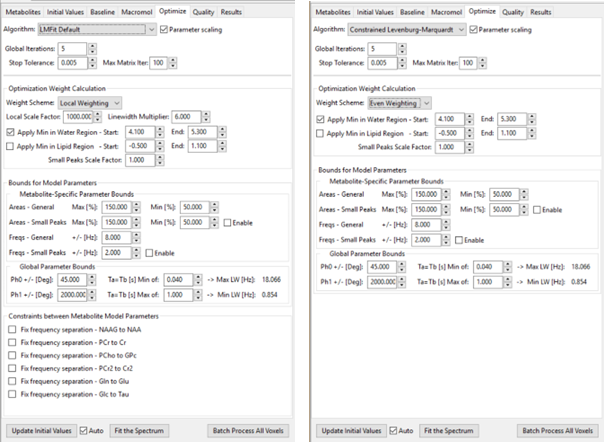
-
Optimization Algorithm - These settings pertain to the optimization algorithm in general.
-
Algorithm - (drop list) Selects the optimization algorithm from None or Constrained Levenberg-Marquardt list.
-
Parameter Scaling - (check) If checked, maintains a workable range between parameters in optimization by scaling prior to the fit, and then un-scaling after the parameters are optimized. This does not affect results.
-
Global Iterations - (spin control) Sets the total number of baseline/metabolite iterations that are performed before stopping the optimization.
-
Stop Tolerance - (spin control) float. Tolerance between iteration inside LM algorithm (recommend 0.01 to 0.001).
-
Max Matrix Iter - (spin control) For iterations inside the LM algorithm (recommend only 20-100).
-
Optimization Weight Calculation
-
Weight Scheme - (drop list) Select the weight array creation from Equal Weighting and Local Weighting methods. Equal method sets all weights to be equal to 1 at all points in the optimization. Local method uses the controls below to set up regions that are weighted more or less in the least squares calculation.
-
Local scale factor - (spin control) The local region is defined as the region near to any spectral lines in the prior information used to create the metabolite basis set. All points within +/- line width times a multiplier (see below) are included. These points are weighted according to the value in this Local Scale Factor widget.
-
Line Width Multiplier - (spin control) Multiplier to determine width of the region around spectral lines that in included in the ‘local ‘ region. This value is multiplied by the estimated line width.
-
Min in Water region - (check, spin controls) Modifies the weight array. A region affected by water suppression pulses can be selected using the start/end values and weighted to a minimum value to minimize its effects on the least squares calculation.
-
Min in Lipid region - (check, spin controls) Modifies the weight array. A region affected by lipid signals can be selected using the start/end values and weighted to a minimum value to minimize its effects on the least squares calculation.
-
Small peaks scale - (spin control) Metabolite peaks other than NAA, Cr and Cho can have this additional scale multiplier added to the weights in their local regions. This causes the fits to these smaller peaks to have more emphasis in the least squares calculation. Recommend (1-5).
-
-
Bounds for Metabolite Model Parameters
- <various> - (spin control) These controls set the range +/- around the initial value that the optimization searches to find a result. The Ta and Tb ranges show what the min or max line width range would be when both have the same min and max range.
-
Constraints between Metabolite Model Parameters (LMFit only)
- <various> - (check) There are six ‘soft bounds' that can be set currently that are hard set in the code (for lack of an interactive GUI input). They maintain PPM separation between NAA/NAAG, PCr/Cr, PCho/GPc, PCr2/Cr2, Gln/Glu, and Glc/Tau. These bounds are only used in the optimization if both metabolites are present in the list of metabolites to be fit. Check boxes should automatically reset to OFF if one or both metabolites are not present. Note – Use the 'User Metabolite Information' dialog to map the names of the metabolites in your basis set to the ‘standard group of abbreviations' that Analysis searches to determine if both metabolites are available for the soft bound. For example, you can have a metabolite in your basis set called ‘bobs_naa' so long as you set up a mapping in the dialog from ‘bobs_naa'-'naa'
6.4.6 On the Quality Panel
On this control panel you set up the calculation of Confidence Limits and Cramer-Rao bounds for the current data set. Both are used as measures of goodness of fit. Cramer-Rao bounds are calculated using only the metabolite model and a measure of the noise in the data. They provide a measure of the range of uncertainty if the absolute best fit has been achieved. Cramer-Rao bounds do NOT tell you if this fit has been achieved.
The Confidence Intervals method makes use of both the data and the metabolite model to measure the variation about the given fit for a given threshold of goodness. Ie. the Confidence Intervals measure the variation around a parameter's value for which the least squares measurement changes only by a given percentage. More details to this method can be found in:
Young K, Khetselius D, Soher BJ and Maudsley AA. Confidence images for spectroscopic imaging. Magnetic Resonance in Medicine; 44:537-545 (2000)
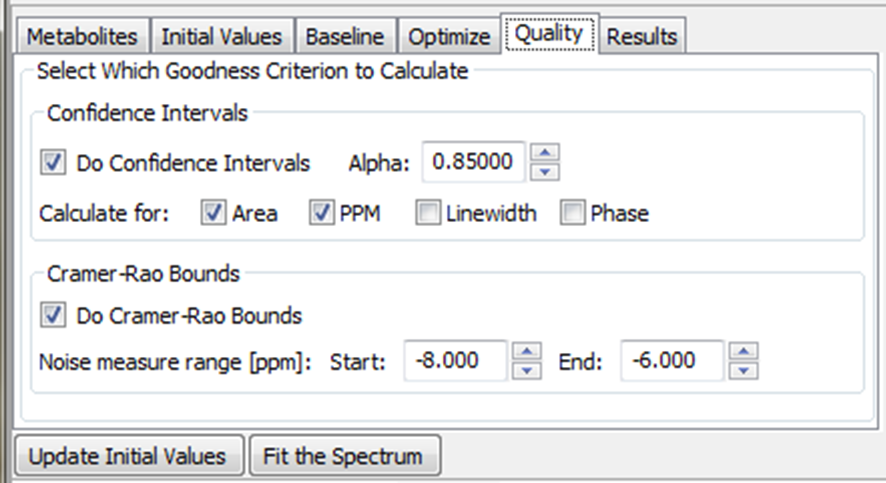
-
Do Confidence - (check) flag. Select whether to calculate confidence interval values.
-
Alpha - (spin control) float. The threshold about the parameter across which the variation is measured. 0.85 shown above means a +/- 15% variation about the fitted value.
-
Calculate for - You can select to calculate limits for specific parameters in order to save on calculation time.
-
Do Cramer-Rao - (check) flag. Select whether to calculate Cramer-Rao bounds.
-
Noise Measure Range - (spin controls) Allows you to specify a region of the data from PPM start to end that an RMS noise calculation can be made from.
6.4.7 On the Results Panel
On this control panel can see a text based report on the results of fitting the data.
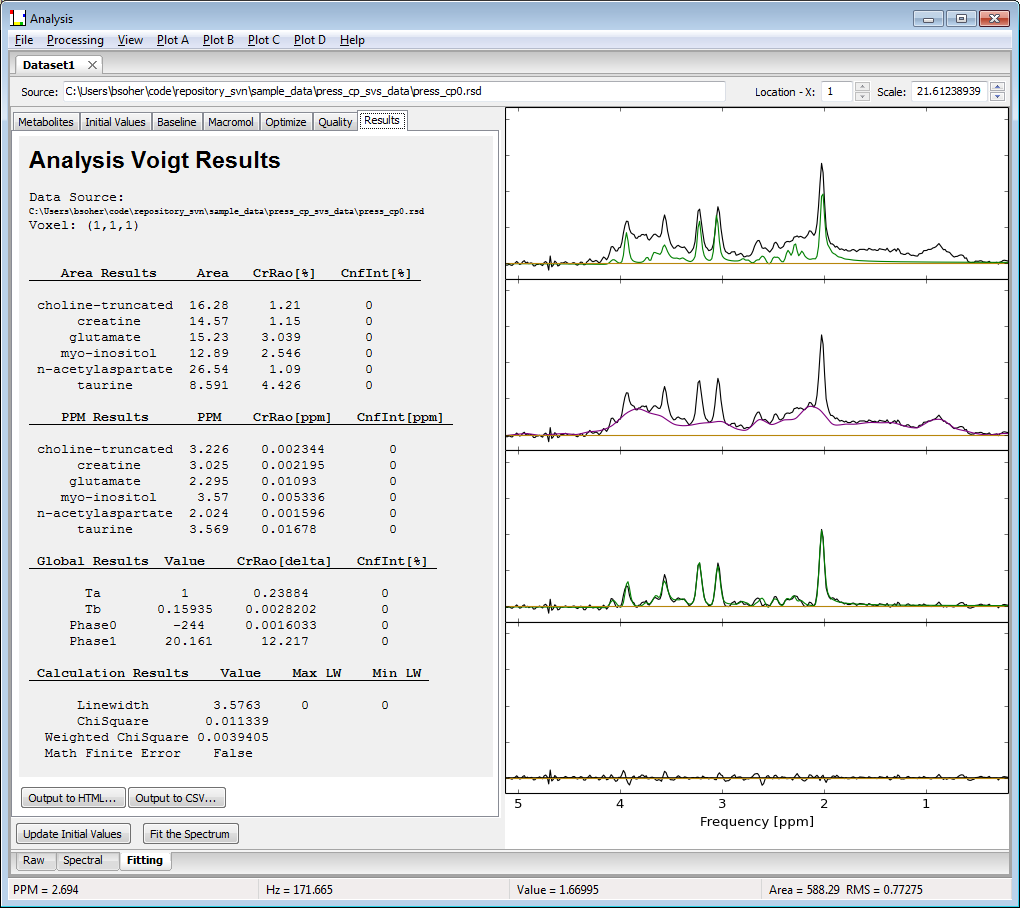
-
Output to HTML - (button) Creates an HTML file to display the text shown above with the plots currently selected in the plot window (left). User must select a filename.
-
Output to CSV - (button) Creates a text file to store the result values shown above in a single line with each value separated by commas. User must select a filename. 1) The last used filename is stored for use as the default the next time the button is hit. 2) If the file does not exist, it is created and a separate header line containing all result column names is added before the result values. 3) If the file exists, the number of comma separated entries in the last line is calculated. If this number differs from the number of result values to be added, then a separate header line containing all result column names is added before the result values.
7. Workflow Tab – Water Reference Quantitation
7.1 General
This tab allows you to calibrate your fitted metabolite areas to a reference spectrum containing a water peak.
Note. The parameters used in this Workflow Tab are entirely provided by the user. While, they do have default settings, none of the values are calculated from the loaded Dataset.
The menu item Processing→Add WaterRef Quant Tab Adds a ‘Quant' workflow tab to Dataset Tab. The ‘Quant' tab requires that a Fitting tab is already in the workflow. You will also need to have a second Dataset Tab loaded with a fitted water peak. This can be added either before or after the Quant tab. However, the Quant tab can not perform its calculations before a reference Dataset Tab has been selected. An example of the Quant tab is shown below, its format is similar to the Fitting-Results sub-tab, but metabolite ‘areas' are reported as [mM]:
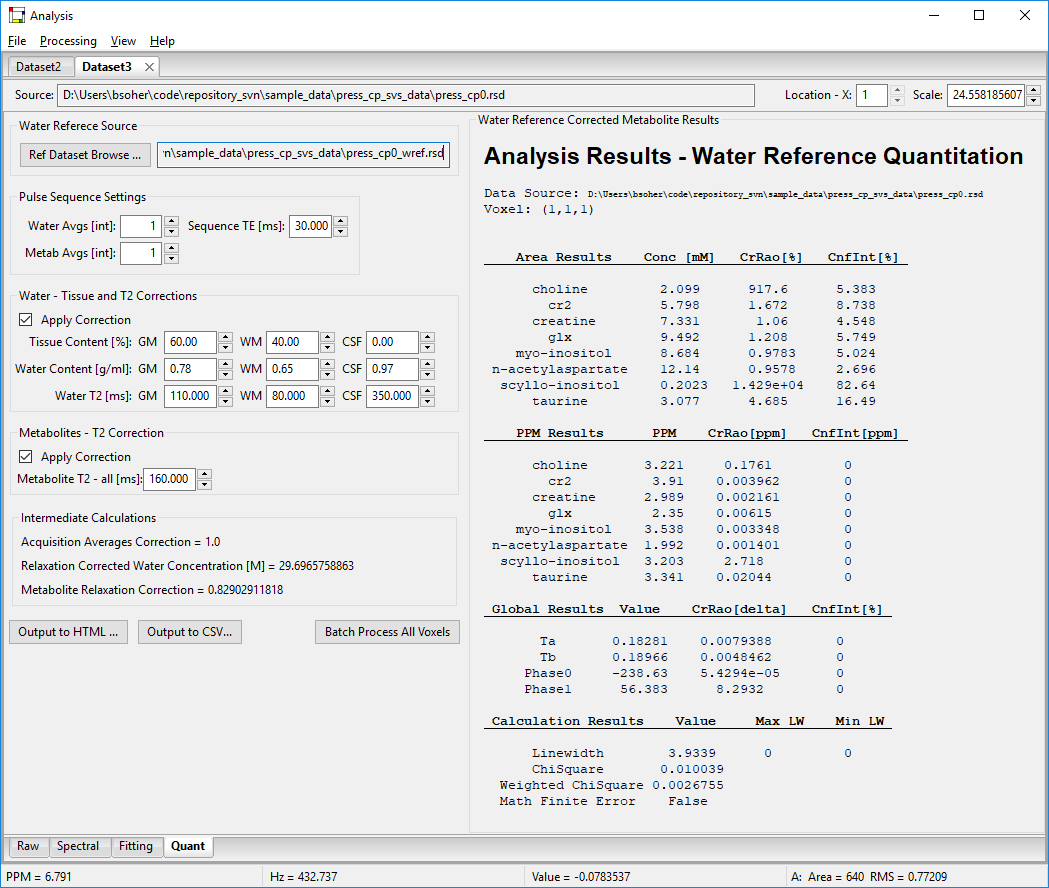
The Notebook, above, has two Dataset Tabs open. Dataset1 is active and has the fitted metabolite spectrum loaded and the Quant workflow tab displayed. Note that the Quant tab does not have any Plot results. Rather the right hand side of the window displays the quantitated metabolite results in HTML tabular form. Dataset2, which is not active, contains a fitted water spectrum used as the reference peak for the calibration algorithm.
###
7.2 Calibration/Quantitation Algorithm
In general, the algorithm can be stated as:
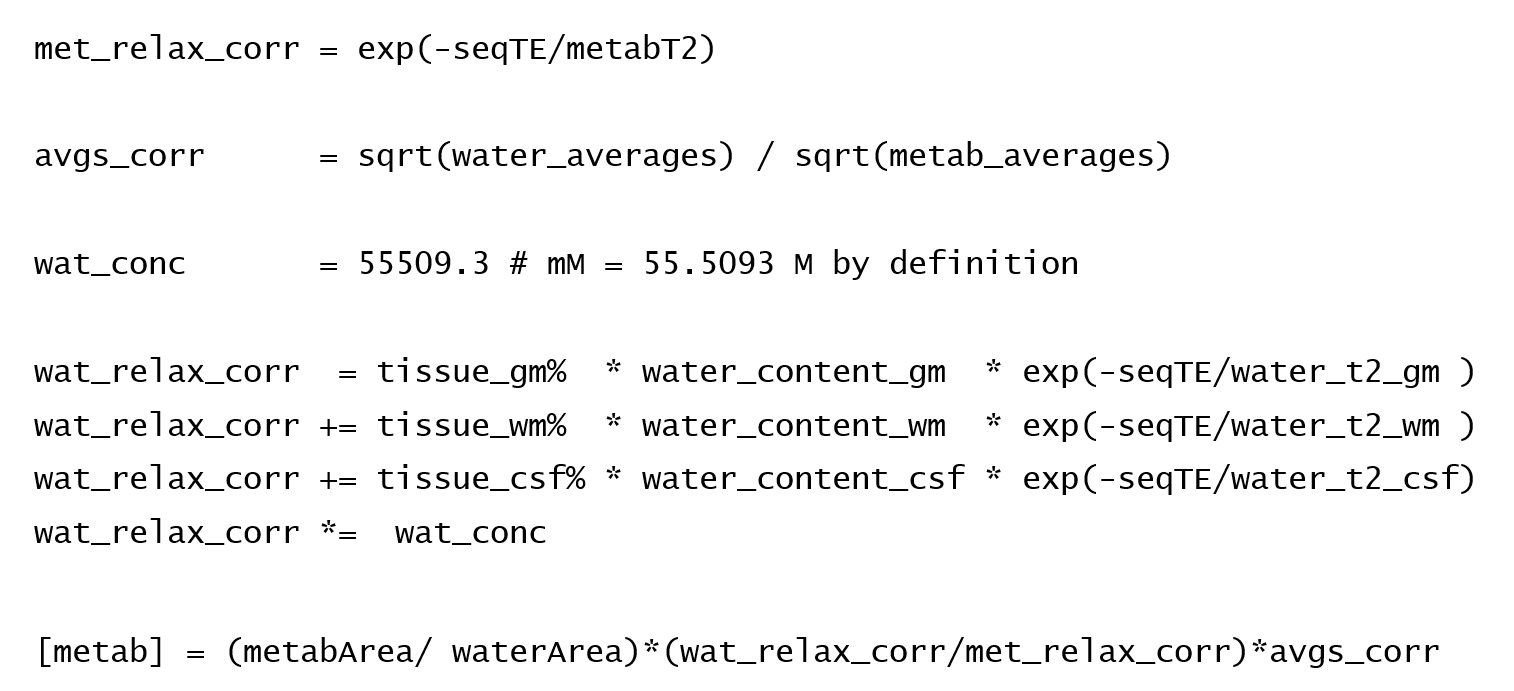
Where metabArea and waterArea are Fitting values calculated in the two Datasets.
7.3 On the Spectral – General Parameters Sub-tab
There are 5 panels on the Quant workflow tab:
-
Water Reference Source Panel – click on "Ref Dataset Browse…" button to pop up a dialog to select a Dataset in the Notebook that has a fitted water peak in its Fitting workflow tab. The selected Dataset must have fitted results, and the list of metabolite names must contain a one that has ‘water' or ‘h2o' within one of the names. Error checking is fairly primitive at this point, if one or more of these conditions is not met, then the algorithm exits quietly and does not update the results window.
-
Pulse Sequence Settings – use these fields to manually set the number of averages taken in the water acquisition, the number of averages taken in the metabolite acquisition, and the sequence TE used to acquire both.
-
Water – Tissue and T2 Corrections – click on the Apply Corrections box to apply this correction as part of the algorithm. A value of 1.0 is used if this is turned off. Set Tissue Contents as percentages for each tissue type. These should add up to 100 when set properly. Set Water Content as a value between 0.0 and 1.0. Set Water T2 values for each tissue type in [ms].
-
Metabolite – T2 Corrections – click on the Apply Corrections box to apply this correction as part of the algorithm. A value of 1.0 is used if this is turned off. Set the metabolite T2 value to use in the algorithm. At this time, the same value is used for all metabolites.
-
Intermediate Calculations – These are all constant values, not editable by the user. They reflect the values of the various corrections as calculated within the algorithm. They are updated each time the algorithm is run successfully.
7.3 Results Output
There are two buttons for saving the water referenced results to file at the bottom of the Quant tab parameter window. Both work the same way as the buttons with the same name in the Fitting tab's Results sub-tab.
-
Output to HTML - (button) Creates an HTML file to display the text shown above with the plots currently selected in the plot window in the Fitting tab. User must select a filename.
-
Output to CSV - (button) Creates a text file to store the result values shown above in a single line with each value separated by commas. User must select a filename. 1) The last used filename is stored for use as the default the next time the button is hit. 2) If the file does not exist, it is created and a separate header line containing all result column names is added before the result values. 3) If the file exists, the number of comma separated entries in the last line is calculated. If this number differs from the number of result values to be added, then a separate header line containing all result column names is added before the result values.
8. Results Output
8.1 Plot results to image file formats
The plots displayed in all workflow tabs which contain View panels can all be saved to file in PNG (portable network graphic), PDF (portable document file) or EPS (encapsulated postscript) formats to save the results as an image. The Vespa-Analysis View menu lists commands that only apply to the active Dataset Tab and the active Workflow Tab. Select the View→Output→ option and further select either Plot to PNG, Plot to PDF or Plot to EPS item. The user will be prompted to pick an output filename to which will be appended the appropriate suffix.
8.2 Plot results to vector graphics formats
The plots displayed in all workflow tabs which contain View panels can all be saved to file in SVG (scalable vector graphics) or EPS (encapsulated postscript) formats to save the results as a vector graphics file that can be decomposed into various parts. This is particularly desirable when creating graphics in PowerPoint or other drawing programs. At the time of writing this, only the EPS files were readable into PowerPoint.
The Vespa-Analysis View menu lists commands that only apply to the active Dataset Tab and selected Workflow Tab. Select the View→Output→ option and further select either Plot to SVG, or Plot to EPS item. The user will be prompted to pick an output filename to which will be appended the appropriate suffix.
8.3 (Fitting Tab only) Fitting Plot/Text results to Standard Layouts
The main differences between this option and the two above is that this option is only available in the Fitting tab, and the format layouts are fixed. The above outputs reflect any changes made to the plots on the screen, these formats do not.
Fitted spectral data results can be output to a number of standard layouts in PDF and PNG formats using the View→ResultsToFile menu option. Current layouts include an ‘LC Model – like' format and Vespa-Analysis 2 and 4 plot options as shown below. Note that all these outputs are image based (PDF and PNG) although they contain text within the image. Also, the plots are currently constrained to plot between 5.0 and 0.0 ppm.
View→ResultsToFile→LCM Layout
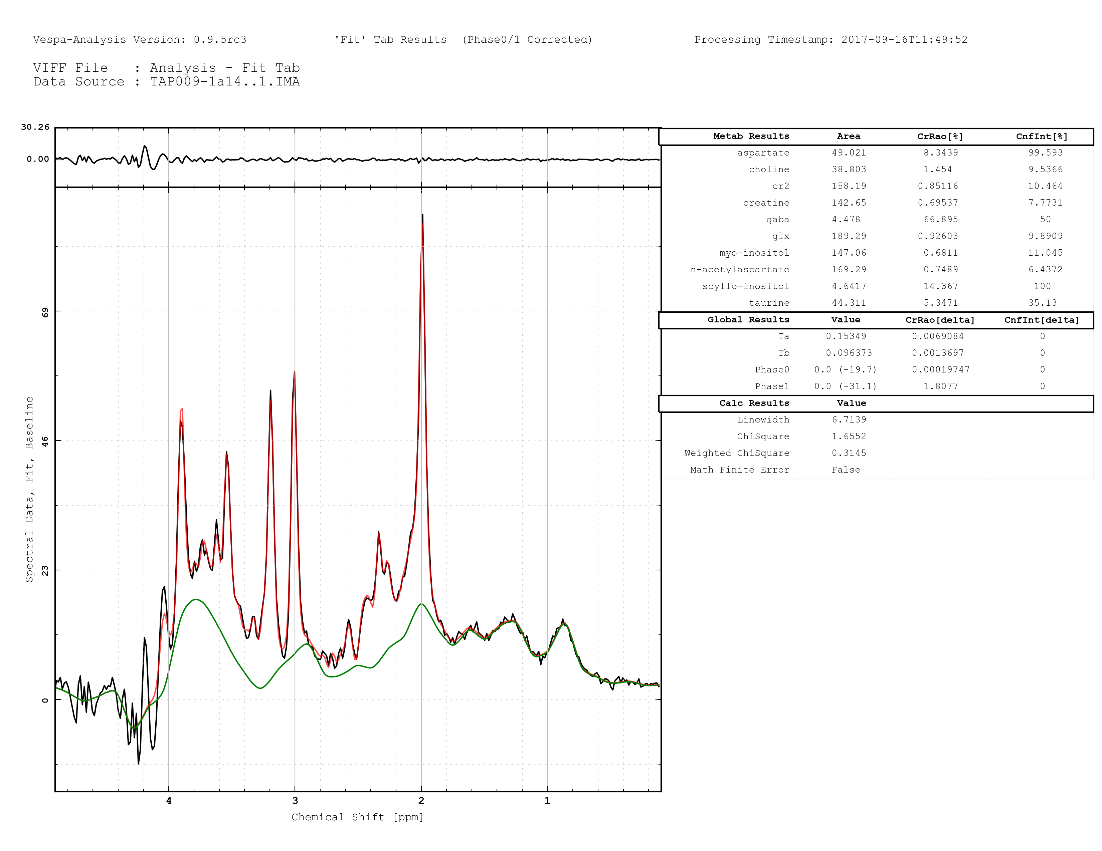
View→ResultsToFile→Analysis 2 Plot Layout
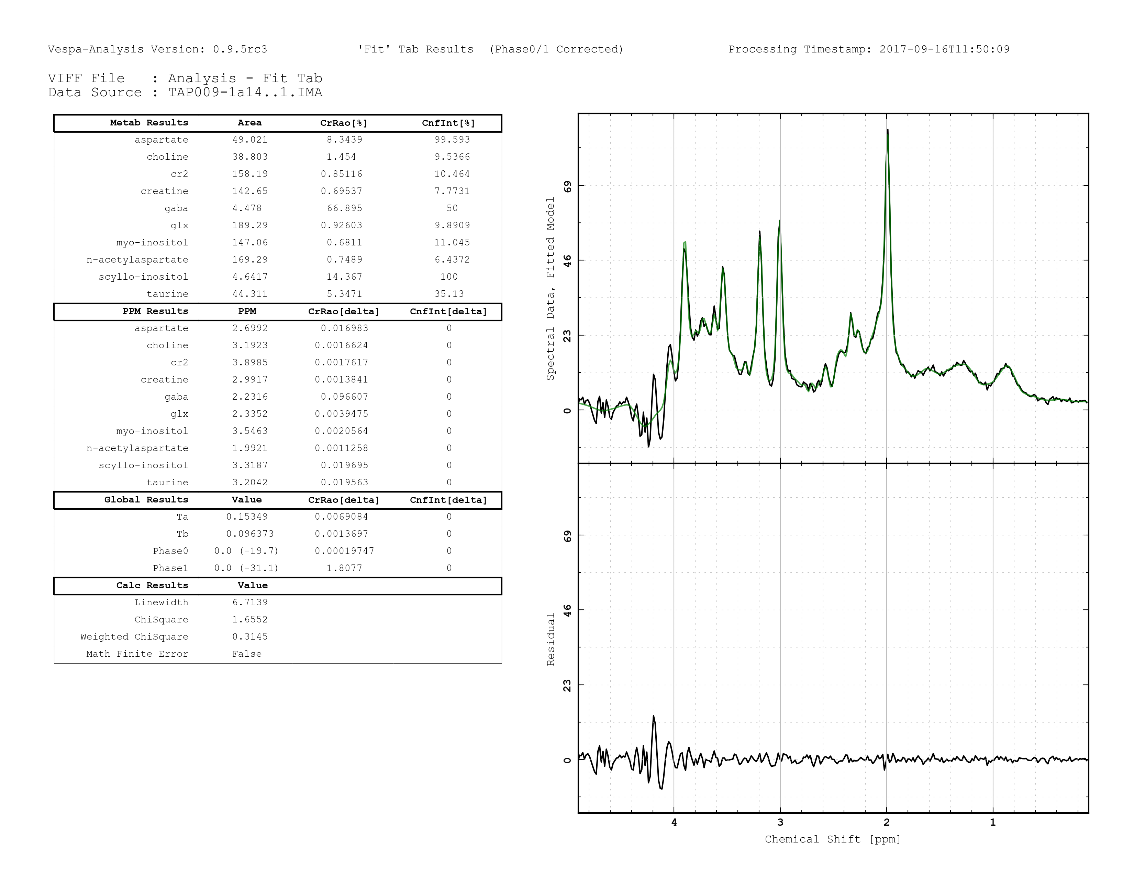
**
**
View→ResultsToFile→ Analysis 4 Plot Layout
Plot 1 - Fit+Baseline (green) overlaid on Raw Data (black)
Plot 2 – Baseline (purple) overlaid on Raw Data (black)
Plot 3 – Fit (green) overlaid on Raw Data – Baseline (black)
Plot 4 – Residual data (Raw – Fit – Baseline) (black)
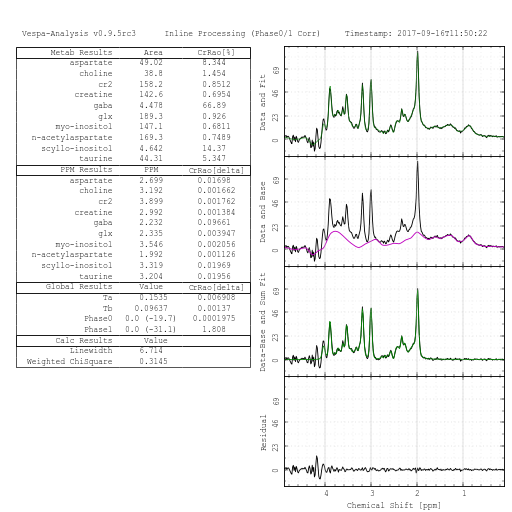
Appendix A. Tutorials
Data referred to in these tutorials need to be downloaded from the Vespa Analysis wiki at:
https://vespa-mrs.github.io/vespa.io/user_manuals/files/tutorial_data_analysis.zip
Data is in a zipped file called tutorial_data_analysis.zip. The zipped data file contains a parent directory called tutorial_analysis. The sub-directories are numbered to correspond to the sections below. For the most part, the data that we will import will be in the VASF (VA San Francisco) data format because it is a simple format to understand and that is what we have our de-identified data stored in.
A.1 Importing a data file into a dataset
Tutorial Data: ~/tutorial_analysis/tutorial_01_import-file
Goal: In this tutorial we will learn how to import data from a single data file into Analysis. We will examine the basic functionality of the Raw and Spectral tabs. We will save and open the processed data into an Analysis VIFF (Vespa Interchange File Format) file.
Run Vespa-Analysis, you will see the Welcome screen stating that no datasets are loaded
Select File→Import→VASF and navigate to the directory above, select the press_cp0.rsd file
A Dataset Tab will appear populated with Raw and Spectral workflow tabs. The Spectral workflow tab should be active.
Select the Raw workflow tab, note that the header information on the right is for the filename listed on the left.
Select the Spectral workflow tab. Click once in the plot to make that active. Click and drag the left mouse button to zoom in on the plot. Left click in place to zoom back out.
Click and drag the middle mouse button (or scroll ball) moving the mouse up-down to set the phase 0 and left-right to set the phase 1 values. Note that the Phase0 and Phase1 widget values on the left change interactively as the mouse moves.
Right click and drag to set a reference span in the data plot. Note that the area value and cursor location values in the status bar change interactively.
Roll the scroll button up-down to change the y-scale value for all plots.
Select File→Save, enter a file name or use the default, press_cp0.xml
Select File→Open, and navigate to the tutorial directory, select the xml file you just saved. This should open up in a separate Dataset Tab. While this data comes from the same file into which the original dataset was saved, the data in this tab is a unique copy and will not affect or be affected by changes made to the other dataset. If you choose to save both datasets to the original file name, this will overwrite the data in that file and only the last tab saved will be available in the future. Use File→SaveAs to save a Dataset Tab to a new name.
Note. For convenience, each time you import data of a particular type (VASF, Siemens DICOM, etc.) the program will by default start in the last directory you used to get a file of that type.
A.2 Importing multiple files into a Datastack
Tutorial Data: ~/tutorial_analysis/tutorial_02_import-stack
Goal: In this tutorial we will learn how to import data from multiple data files to create a Datastack in an Analysis dataset. We will learn to navigate and process individual voxels.
Run Vespa-Analysis, you will see the Welcome screen stating that no datasets are loaded
Select File→Import→VASF and navigate to the directory above, select all three files shown press_cp0.rsd, press_cp4.rsd and press_cp7.rsd
A Dataset Tab will appear populated with Raw and Spectral workflow tabs. The Spectral workflow tab should be active. The press_cp0 data set should be displayed.
Select the Raw workflow tab. You should see three filenames listed in the left panel. Click on each filename and carefully examine the (small) differences in the header information.
Select the Spectral workflow tab. Click on the Location-X widget to scroll through the three spectra. Use the mouse to set different Phase 0/1 values for each spectrum. Zoom in on the 1-4.5 ppm range. Set a reference span from 1.5 to 2.01 ppm. Click through the three spectra and note how far the NAA peak is frequency shifted from its proper location at 2.01 ppm. Use the B0 widget in each voxel to line up the NAA peaks.
Select File→Save and give this dataset a name. You can use the default (which is press_cp0.xml because it is the first of the three files selected) or choose your own. Use your file browser to check the tutorial directory and note that the data from all three data files have now been stored into one Analysis VIFF file.
Select File→Open and select the file you just saved. This should open into a different Dataset Tab, but contain the same data as in your original tab. This file has the same data dimensions as the first dataset that you opened, so the program allowed it to be loaded into a new Dataset Tab.
Select File→Import→VASF and select only the press_cp7.rsd file. You should see a warning dialog open that looks like this.
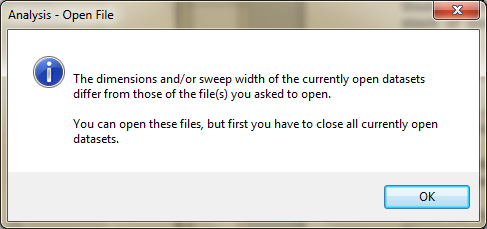
Go ahead and select File→Import→VASF and select all three *.rsd files again. These should open up into a new Dataset Tab with no error message.
The dimensionality of the data you want to load has to match that in any datasets already open. However, the dimensionality is determined not by the number of files (if you are loading a stack) but by the actual dimensions of the final Dataset/Datastack created just prior to it being loaded into a Dataset Tab in the notebook.
A.3 Opening and comparing multiple datasets
Tutorial Data: ~/tutorial_analysis/tutorial_03_open-multiple-datasets
Goal: In this tutorial we will learn how to open multiple datasets into tabs in the notebook.
Run Vespa-Analysis, you will see the Welcome screen stating that no datasets are loaded
Select File→Open and navigate to the directory above, select press_cp0.xml. After this Dataset Tab opens, click on File→Open and select the press_cp4.xml file. This will open into a second Dataset Tab. Note that both of these files are VIFF format and contain phased data in their Spectral tabs.
At this point, you should have Dataset1 and Dataset2 tabs in the notebook. In Dataset1, click on the PlotB drop menu, you should see that there are three values, None, Dataset1 and Dataset2. Select Dataset2 and the plot will reconfigure to show three axes. The top is the data for Datase1, middle is Dataset2 data and bottom is the subtraction of top-middle.
Position the mouse in the top spectrum. Middle-click and drag and the top spectrum will be phased. The Phase 0/1 widgets to the left will show the interactive change of these values. The bottom (subtraction) plot will reflect the phase changes interactively as well.
Position the mouse in the middle spectrum. Middle-click and drag and the middle spectrum will be phased regardless of where the mouse travels (so long as you don't release the middle button). The Phase 0/1 widgets to the left will not show any changes because we are changing the Dataset2 phase values. If you switch to Dataset2 tab, you will see that it has the same phase as that shown in the middle plot for Dataset1. Conversely, if you change the phase in Datase2, this will be reflected in the middle plot of Dataset1. The bottom (subtraction) plot will reflect the phase changes interactively as well.
Close Dataset2 by clicking on the X in its tab. Note that the Dataset1 tab reconfigures itself to set PlotB to None and have only one Plot.
A.4 Applying ECC correction using an associated dataset
Tutorial Data: ~/tutorial_analysis/tutorial_04_eddy-current-correction
Goal: In this tutorial we will learn how to open multiple datasets into tabs and then associate them so that the eddy current correction (ECC) algorithm will have the water data needed to correct the water-suppressed data.
Run Vespa-Analysis, you will see the Welcome screen stating that no datasets are loaded
Select File→Import→VASF and navigate to the directory above, select press_cp4.rsd. Select File→Import→VASF and select press_cp4_wref.rsd. At this point you should have two Dataset Tabs open, Dataset1 with the metabolite (water-suppressed) data and Dataset2 with the water data.
Click on Dataset1, and select the Spectral tab. From the Eddy Current Correction Filter drop menu select ‘Traf'. The widgets will reconfigure to show a Ecc Data Browse … button with no file name in the field to the right. Click on the Browse button and in the dialog that appears, select the press_cp4_wref.rsd file from the list of open datasets (you may need to resize the dialog to see the entire filenames).
The algorithm is applied directly after you select the water file. You can switch back and forth between None and Traf in the drop menu to see the change in the data due to the ECC filter. Note. In this example data the change is not very significant … if you want to send us poor data with a better improvement, please feel free!
Click on File→Save and give the output file a name. Check in the tutorial directory and you will see that only one xml VIFF file has been created. Since the water file is used in the ECC processing of the metabolite data, it is assumed to be associated with that dataset. When we saved it, both sets of data were written to the VIFF file.
Note. In the tutorial directory, I have already saved a file called press_cp4_with_ecc.xml. I recommend that you annotate the default filename to indicate that a VIFF file contains associated data as well as the main dataset.
Close both Dataset Tabs.
Click File→Open and select the VIFF file that you just created. This will open up two Dataset Tabs, showing both the metabolite and water data files stored in the VIFF file.
A.5 Interactive SVD filtering of unwanted signals
Tutorial Data: ~/tutorial_analysis/tutorial_05_interactive_svd_filtering
Goal: In this tutorial we will learn how to use the Spectral – SVD Filter Parameters sub-tab in order to filter unwanted signals from a short TE spectrum.
Run Vespa-Analysis, you will see the Welcome screen stating that no datasets are loaded
Select File→Import→VASF and navigate to the directory above, select press_cp0.rsd. This file will open into a tab called Dataset1 and default to displaying the Spectral – General Parameters sub-tab.
The SVD algorithm was run when this voxel was displayed (either on opening or when the Location-X widget was clicked). Select the SVD Filter option from the Signal Filtering drop list. Now click on the SVD Filter Parameters sub-tab to start working with the results displayed.
In the SVD tab on the left panel are all the controls for setting parameters for the SVD algorithm. For each voxel in a dataset you can define how many points of the FID to use, how many exponential lines to allow in the model, the Hankel matrix size and the maximum number of iterations allowed internally in the algorithm. As you change the parameter values the algorithm is automatically re-run and results are displayed in the scroll window at the bottom of the left hand panel.
There should be 6 columns displayed in the results widget: Line, PPM, Freq, Damping, Phase, and Area. Checking a box in the Line column will select it to be removed from the original spectrum. Damping values are given in ms, phase is in degrees. Clicking on the All On or All Off buttons will set or de-select all check boxes respectively.
Try changing some parameter values and seeing how results differ. Make sure to hit the All On button on the bottom of the panel after you change each parameter. This will display all the SVD calculated lines in the middle plot. The residual signal will be displayed in the bottom plot. You can zoom in to different regions to better see the lines in the SVD model.
If you click in the Threshold radio box, then the value in the Threshold spin control widget will be used to decide which SVD results to remove from the spectrum. For example, if the spin control is 11, then all SVD results that are less than the center frequency + 11 Hz will be removed from the spectrum. This can be a bit confusing to visualize since the x-axis is typically shown in PPM values, but it is more easily seen in the SVD tab where the center frequency is shown in the Freq column as 0 Hz. So, all SVD lines at 11 Hz or less would be removed. Note that if the Apply Threshold radio box is not checked then the values manually selected in the SVD tab will be used to remove signals from the Spectral plot.
You can also use the mouse to select lines in regions of the plot. Just check on the Cursor span radio box. Then as you click-drag with the right mouse button, any SVD lines in the reference span region will be selected as on in the results list. Note that this can only be used to turn on lines, not turn them off. Click on the All Off button to reset the results list and start over if necessary.
A.6 Example of a fitted short TE PRESS data set
Tutorial Data: ~/tutorial_analysis/tutorial_06_fitting_press_te24
Goal: In this tutorial we will demonstrate what a fitted short TE PRESS data set looks like. We will see how to load prior information from file. We will interactively set initial values and we will generally introduce the other tabs in the Fitting workflow tab.
Run Vespa-Analysis, you will see the Welcome screen stating that no datasets are loaded
Select File→Open and navigate to the directory above, select press_cp0.xml. This file is saved in VIFF format and will open into a tab called Dataset1. There will be five Workflow Tabs populating the Dataset Tab, but the Spectral workflow tab will be active.
Note in the Spectral tab we have removed water signals using HLSVD. We have also adjusted the phase and B0 shifted NAA peak to be at 2.01 ppm.
Click on the Fitting workflow tab. Zoom in on the metabolite region in the plot (approx. 4.5 to 1.5 PPM) if you have not already set up your default plot types for plots A-D, I recommend the following A) Raw and InitialModel, B) Raw and Base, C) Raw and (Fit+Base), D) Raw-Fit-Base. When you quit the Analysis program, these selections will be saved as your preferred plot setup. You should see: The initial values (green) overlaid on the raw data (black) in the top plot. The baseline (purple) overlaid on the raw data (black) in the second plot. The overall fit (green) overlaid on the raw data (black) in the third plot. The residual spectrum is at the bottom plot in black.
Click on the Results parameter tab. You will see a tabular printout of metabolite areas and ppms and global phase and lineshape values. The Cramer-Rao (CrRao) and confidence interval (CnInt) calculations for the fit are also shown. Click on the Output to HTML … button to select a filename to save the table and plots into in HTML format. This can be accessed using any modern browser.
The Metabolites parameter tab can be used to select prior data from either a file or database. Click on the Prior Information from File … button and select the _prior_for_press24_forCP0.xml file from the directory listed above. The program will repopulate the metabolite list and maintain any checked boxes that correspond to metabolites previously selected (yes, since this is the same prior file, all boxes should still be checked, but it's an example). If you had the original experiment saved into the Vespa database from Simulation you could also get the prior directly from there, also.
Click on the N-acetylaspartate Area Scale Factor spin control. You should see the NAA singlet grow or shrink as you change this value. Note that some of the Peak Search Width values have been set to very small values (e.g. 0.01). This is to keep their starting locations at prior ppm values rather than searching for the nearest max peak which might not be accurate for small multiplet structures.
The View menu can be used to select how many plots are shown in the plot window. You can also output these plots to a number of image formats using the View→Output menu.
This is the official end of the tutorial. However, see the notes below about the other parameter tab options.
Initial Values – there are a number of automated routines for setting B0 shift, phase and linewidth values. These are selected by their pull down menus. Clicking on the spin controls for the actual values for these parameters will set the method back to Manual. Note. The Baseline Estimate option is used sometimes to better estimate actual peak heights in the spectrum if it is known to have baseline signals underlying the metabolites. The Savitzky-Golay algorithm is fairly quick, but the Lowess algorithm can take considerable time if the data has a lot of points.
Baseline – The bottom panel will change as you select the Baseline Method. Smoothing Parameters are applied regardless of method (other than for None)
Optimize – Use this panel to better constrain the fit for parameters by setting reasonable ranges in which to search for an optimization. You can set more or less Global Optimizations depending on whether you are testing a setup or running actual data fits. You can emphasize the small metabolite ppm region fits by increasing the Small peaks scale factor, but this can also allow linewidth to increase in some cases.
Quality – You must choose a valid Noise range for Cramer-Rao calculation to be accurate. In Confidence Intervals, you must both turn on the option AND select which parameters to do the calculation for. Just checking the Do Confidence Intervals box is not sufficient.
Appendix B. Importing Data into Vespa
Analysis can import data from a number of 3rd party formats. If you need Analysis to import data from a format that it doesn't currently understand, it's not too difficult to do so as long as you're willing to write some Python code. We've done our best to set up a template which leads you through all the necessary steps. It takes care of interactions with the main program. But, we need you to know how your data is organized and accessed.
In Analysis' Python code, every 3rd party import format has a specific Python class associated with it. That class knows how to read the format and turn it into a Vespa DataRaw object. Appropriately enough, all of the classes that know how to read files and turn them into a DataRaw are subclasses of a Vespa class called RawReader.
You can implement your own RawReader subclass by following the example in this template:
https://github.com/vespa-mrs/vespa/blob/main/vespa/analysis/fileio/template.py
Download that file to your hard drive to a location where it can remain (semi-)permanently so Analysis can find it each time it starts. Rename it to reflect what data you are going to import. Read the comments in the file for hints on how to make it work for your file format.
Note. If someone gives you a 3rd party format I/O file with a RawReader class already written, then all you have to do is install it. Copy the python I/O file to wherever you are storing your other 3rd party format filters. If this is your first, you should create a directory on your computer that will be around semi-permanently so Analysis can always find it. Now follow the rest of the directions below.
When you're ready to test your code, you can add your format to the Analysis menu by editing an INI file. The file is called analysis_import_menu_additions.ini and it's in the Vespa data directory. See this page for instructions on how to find Vespa's data directory:
https://vespa-mrs.github.io/vespa.io/development/project_dev/technical/VespaDataDirectory.html
Follow the instructions in analysis_import_menu_additions.ini to make your format appear on Analysis' menu.
Appendix C. Supported Data Formats
The following data formats are built into the Analysis "import" function.
| Manufacturer | File Format |
|---|---|
| Bruker | Bruker acqus and fid files. Returns one dataset. Currently supports JCAMPDX v4.24 and 5.x formats. |
| GE | PROBE-P P-file (*.7), Returns separate water and metabolite Datasets with either averaged or individual averages/coil data (as available) for preprocessing. |
| LCModel | RAW files. Returns one Dataset. |
| NIfTI-MRS | *.nii files. Returns one Dataset with either averaged or individual averages/coil data (as available) for preprocessing. |
| Philips | *.spar/*.sdat file pairs. Returns one Dataset with either averaged or individual averages/coil data (as available) for preprocessing. |
| Philips | DICOM. Returns one Dataset with either averaged or individual averages/coil data (as available) for preprocessing. |
| Siemens | DICOM. Returns one Dataset with either averaged or individual averages/coil data (as available) for preprocessing. |
| Siemens | *.rda. Returns one Dataset with either averaged or individual averages/coil data (as available) for preprocessing. |
| Siemens | TWIX. Various sequence specific parsers. Returns one Dataset with either averaged or individual averages/coil data (as available) for preprocessing. |
| Varian | procpar and fid files. Returns one Dataset with either averaged or individual averages/coil data (as available) for preprocessing. |
| VASF (*.rsd/rsp) | VA San Francisco file format. Paired files, a text header (*.rsp) and binary data file (*.rsd) that were used to store MRS data. Returns one dataset. |
| VIFF Raw Data (*.xml) | Vespa Interchange File Format is an XML format that is used to exchange data between Vespa applications. In this case, it allows Analysis to read DataSim files. Returns one dataset. |
| Specialized Data | There are a variety of specialized parsers that users select for specific types of data (such as MEGA-PRESS, or CMRR semi-LASER) that contain more than one data type within one file (typically DICOM or TWIX or P-File). These parsers are able to separate each data type into a separate Dataset object. |
See Appendix B for if you need Analysis to import data from a format that it doesn't currently understand, it's not too difficult to do so as long as you're willing to write some Python code.
.